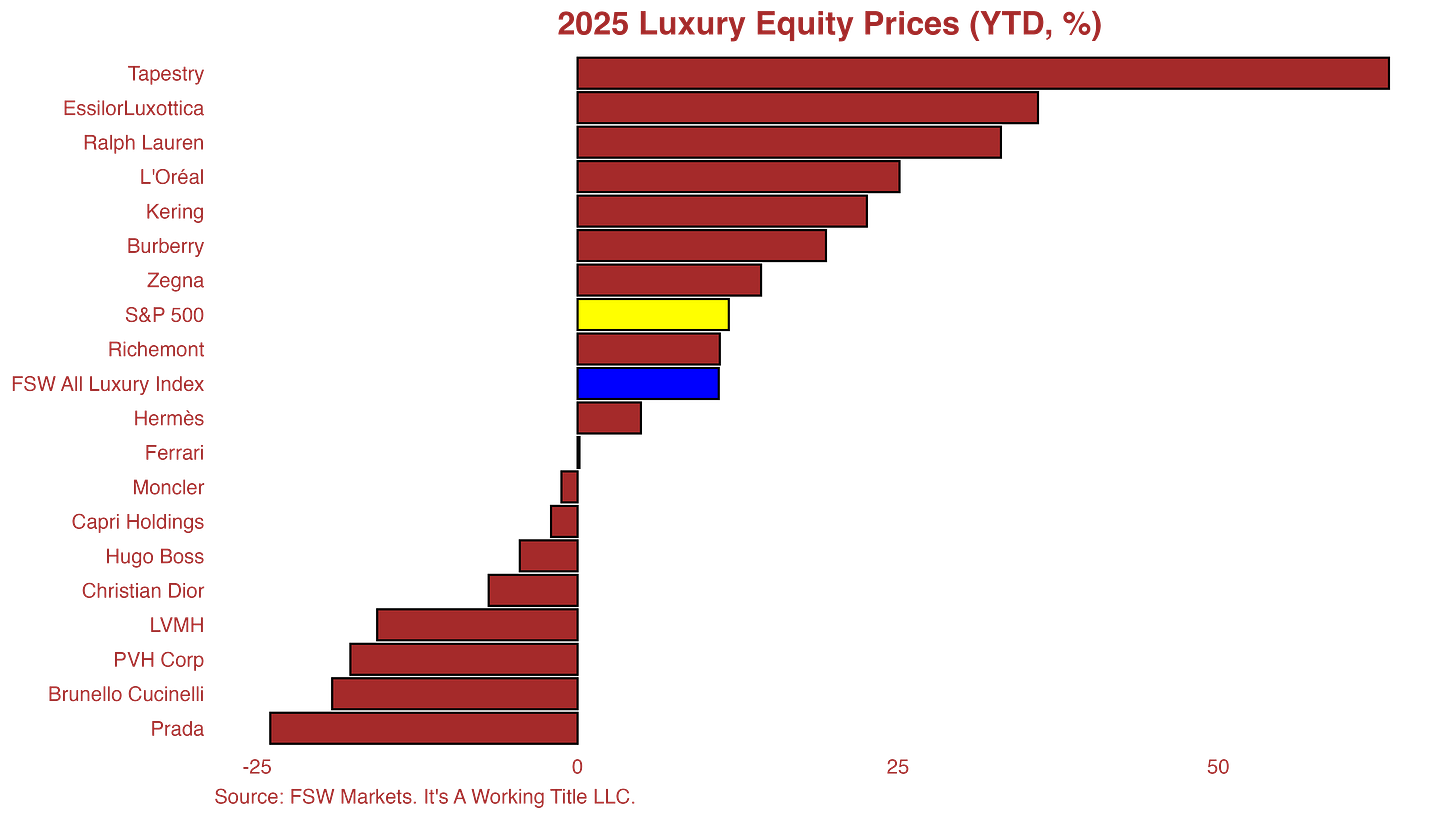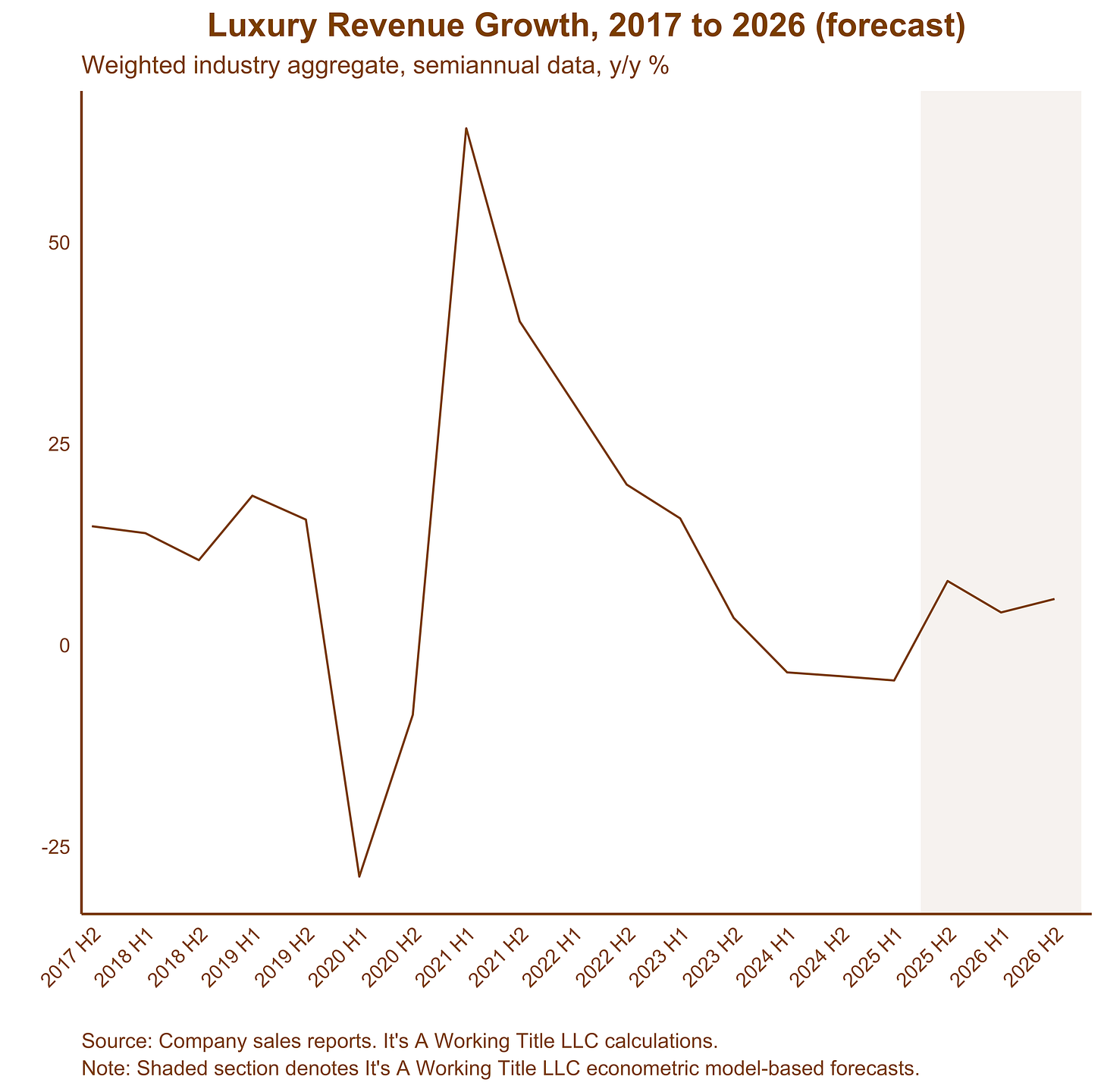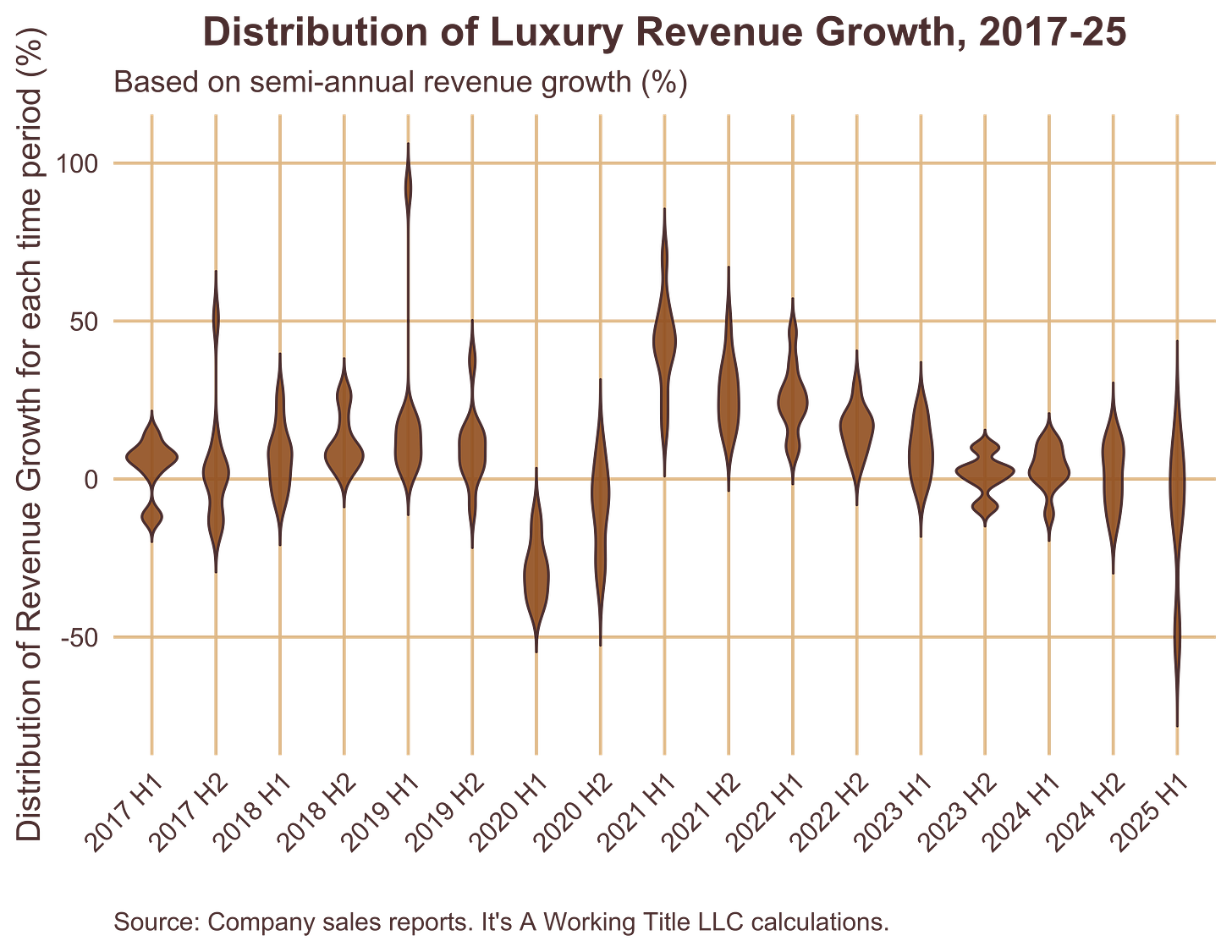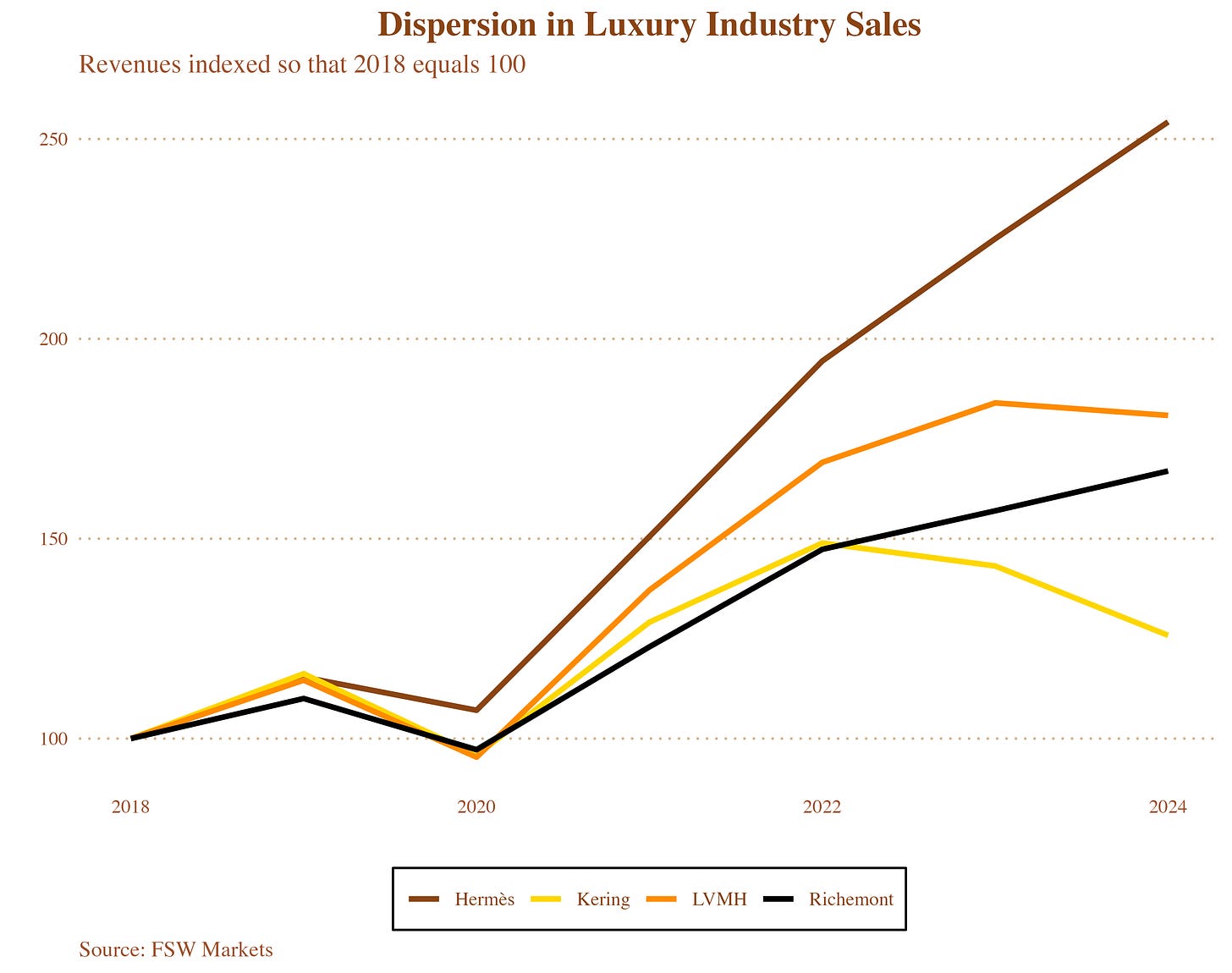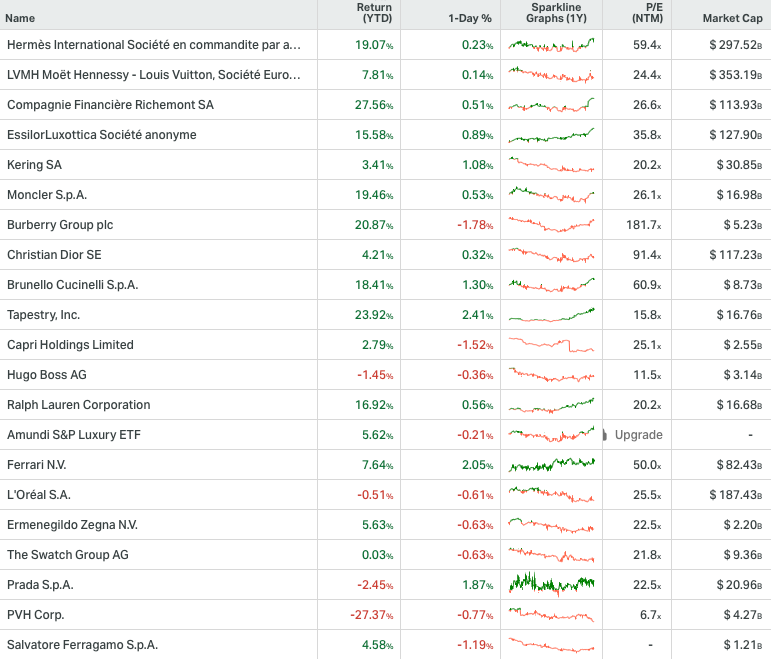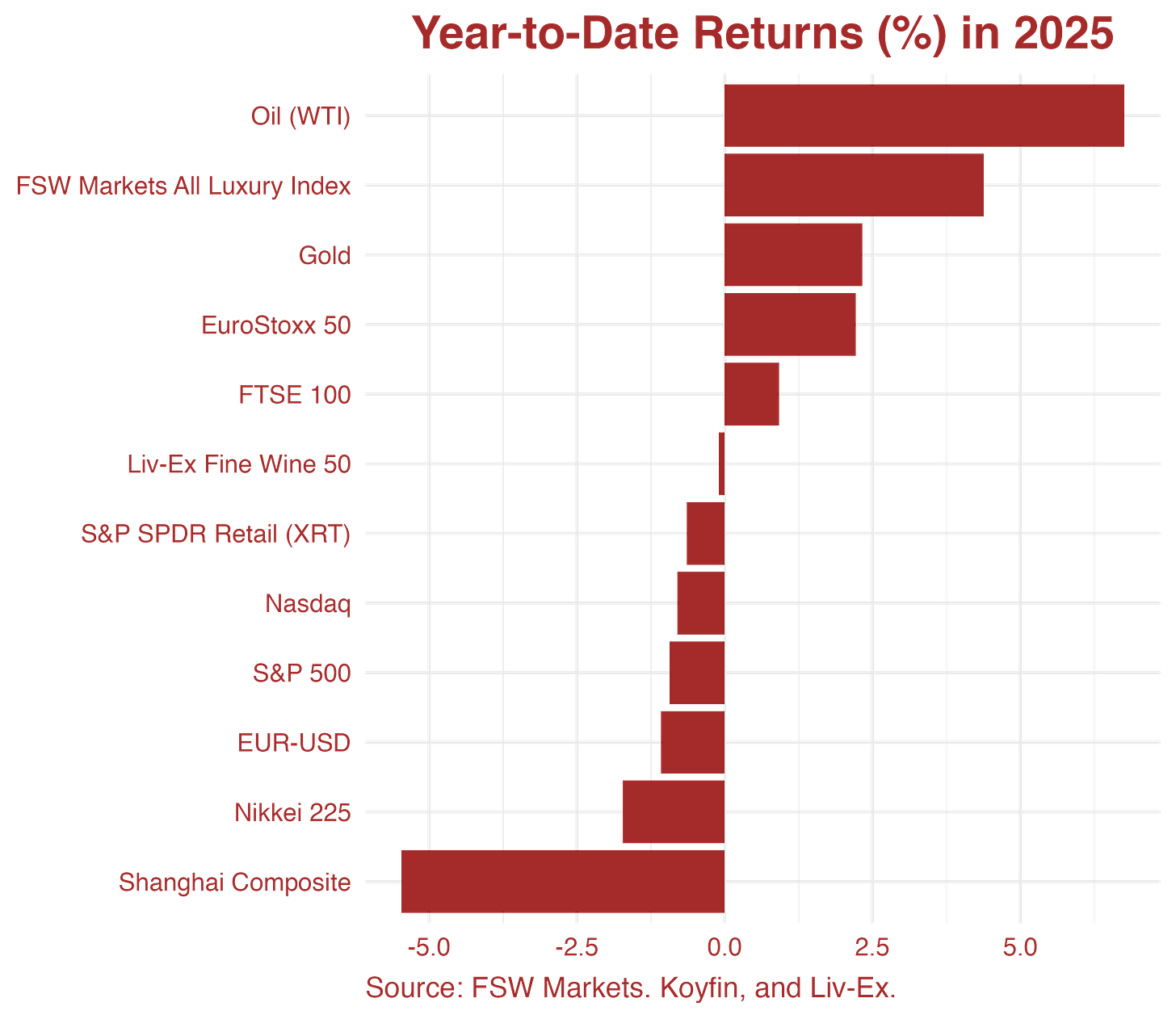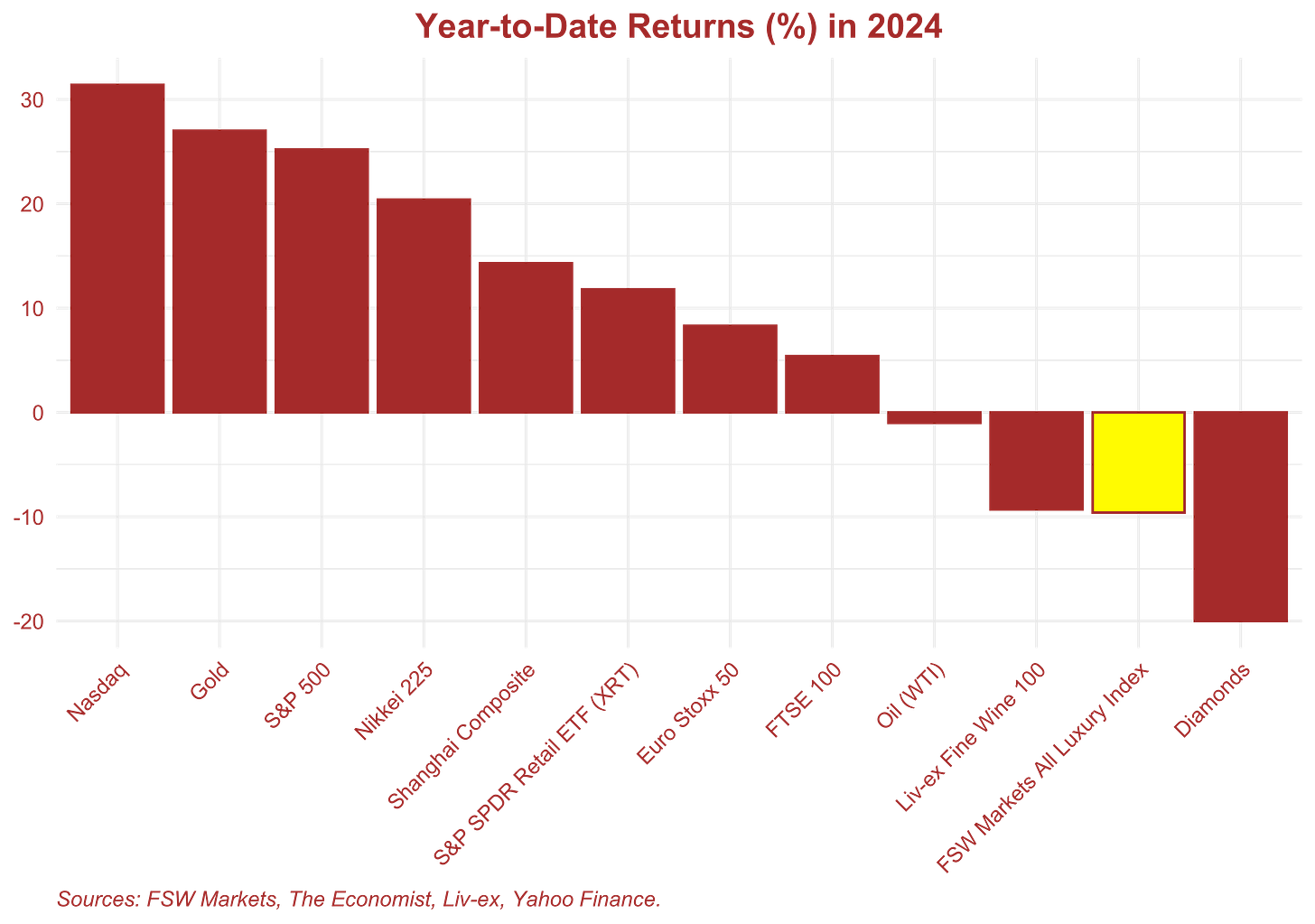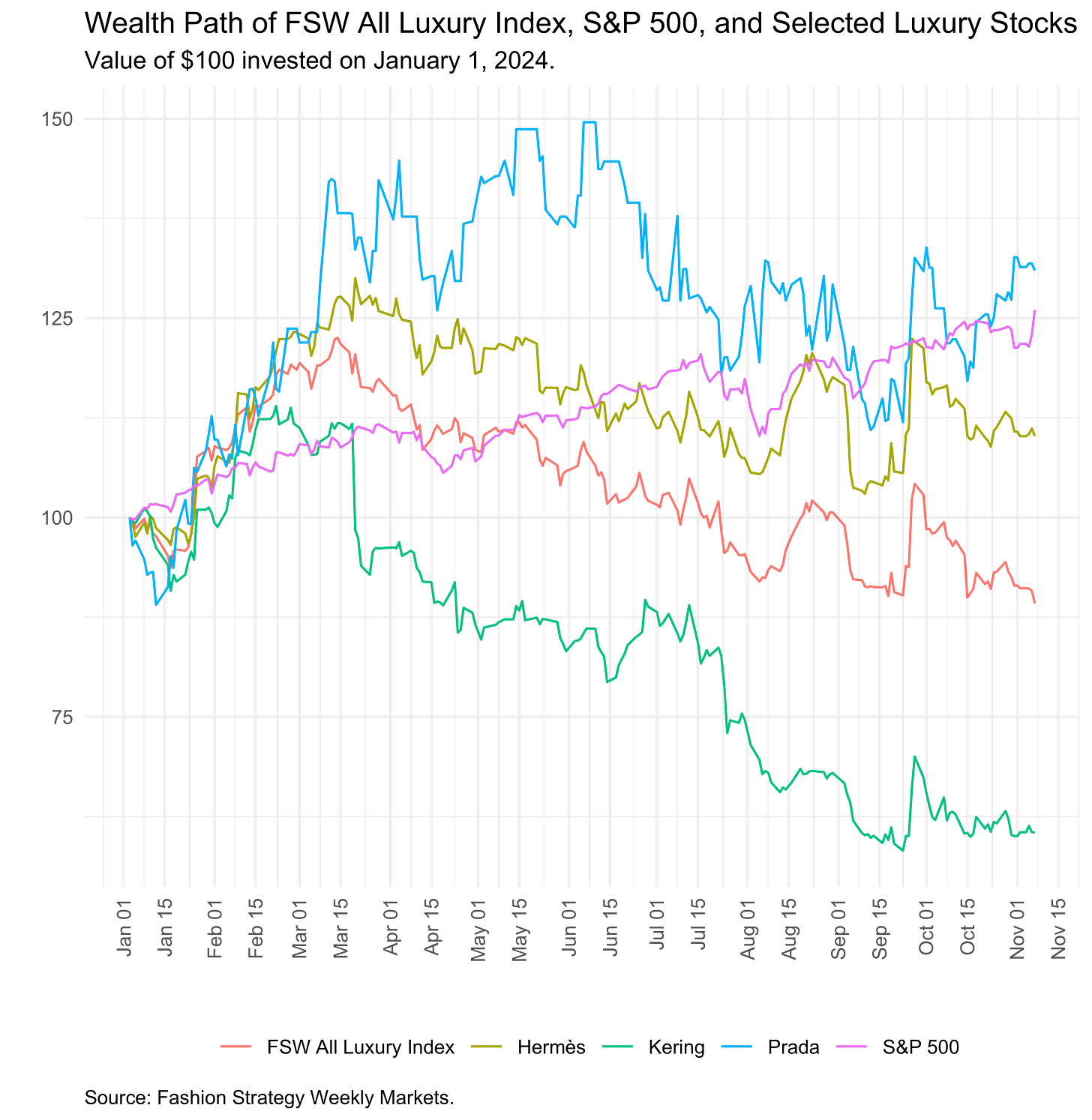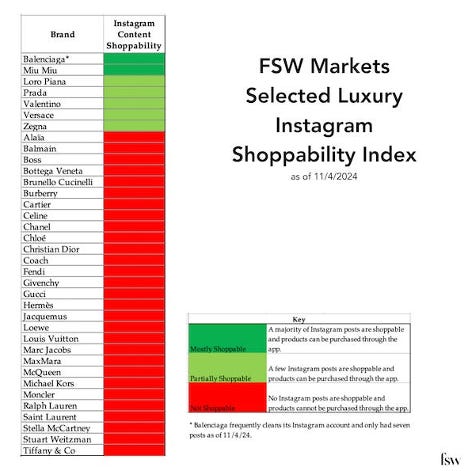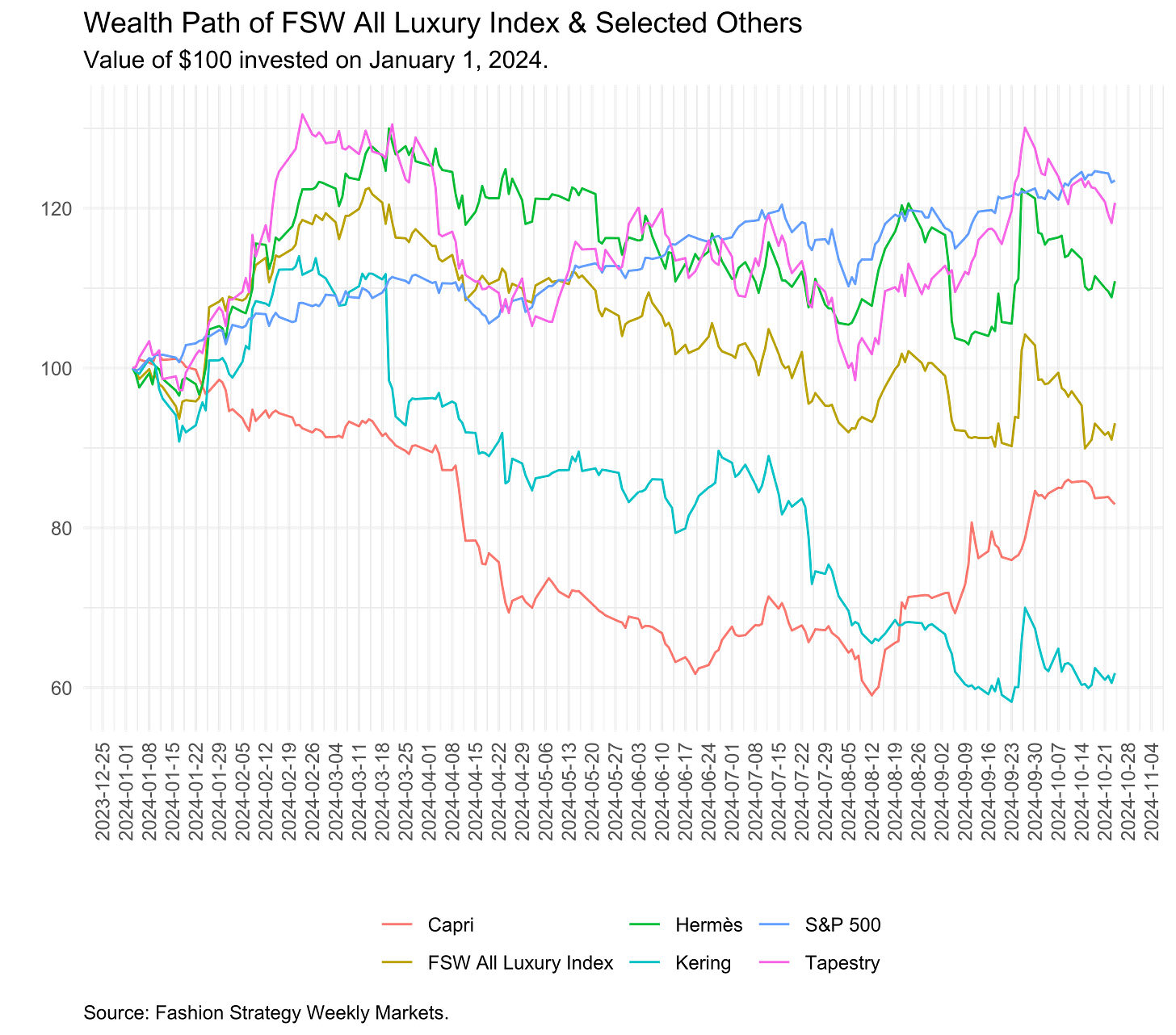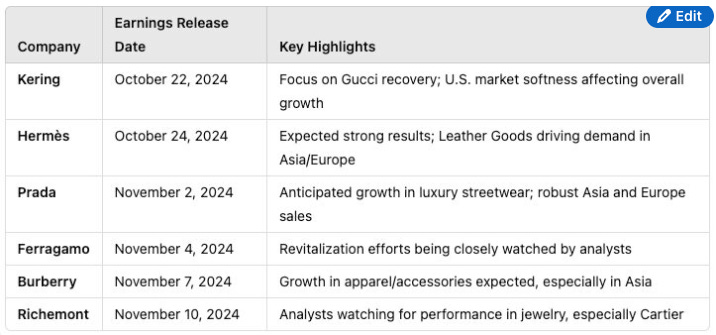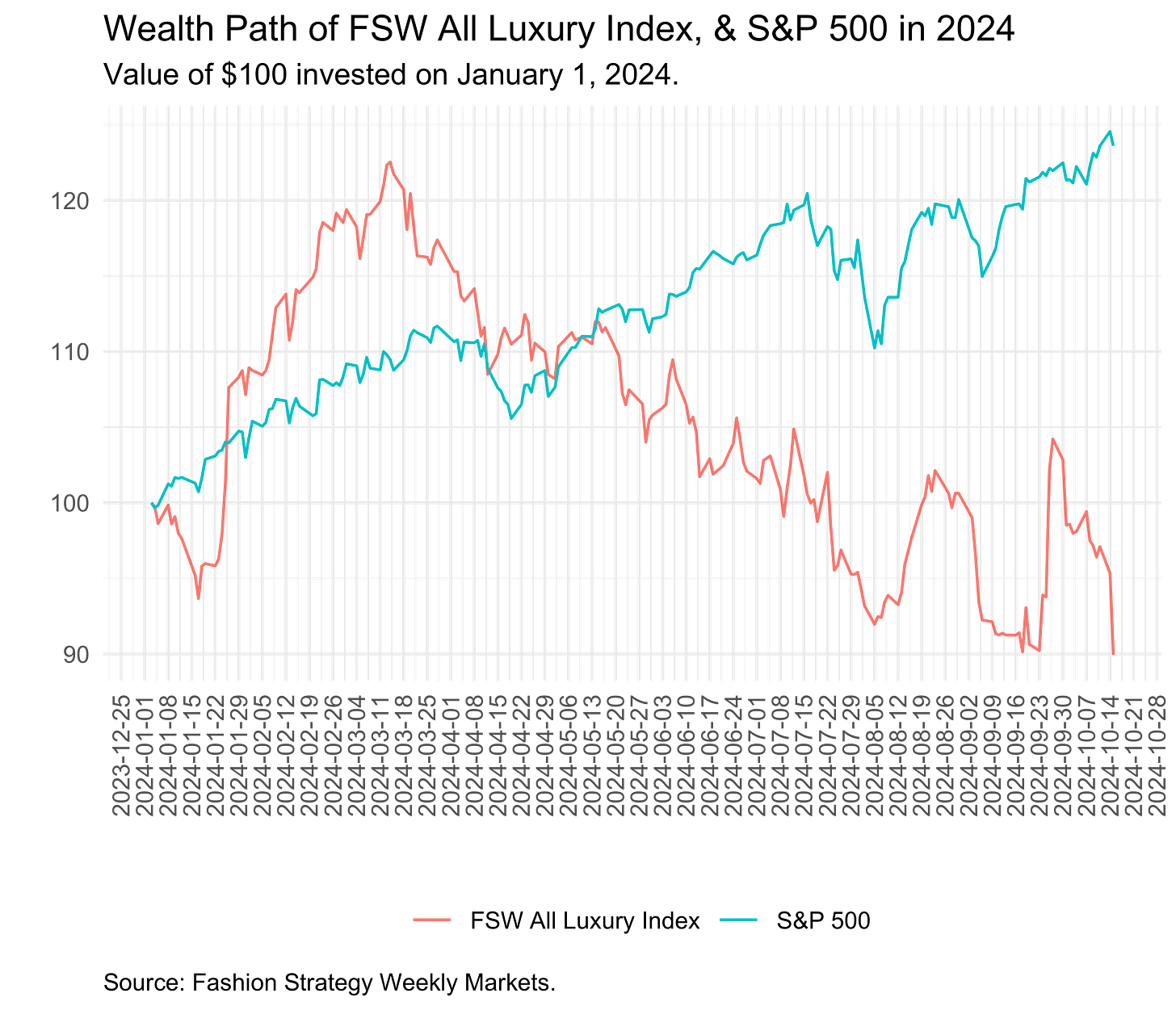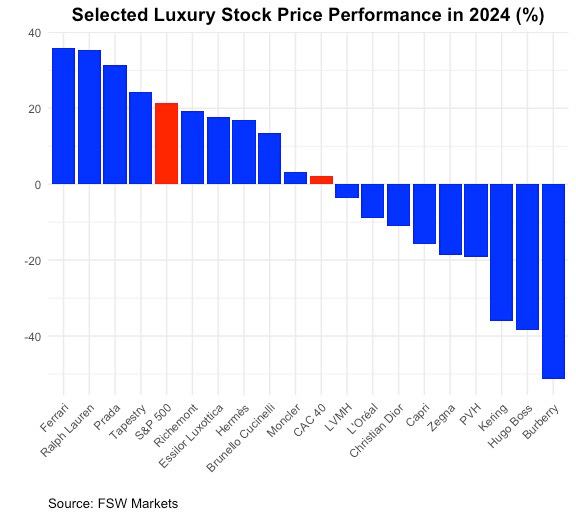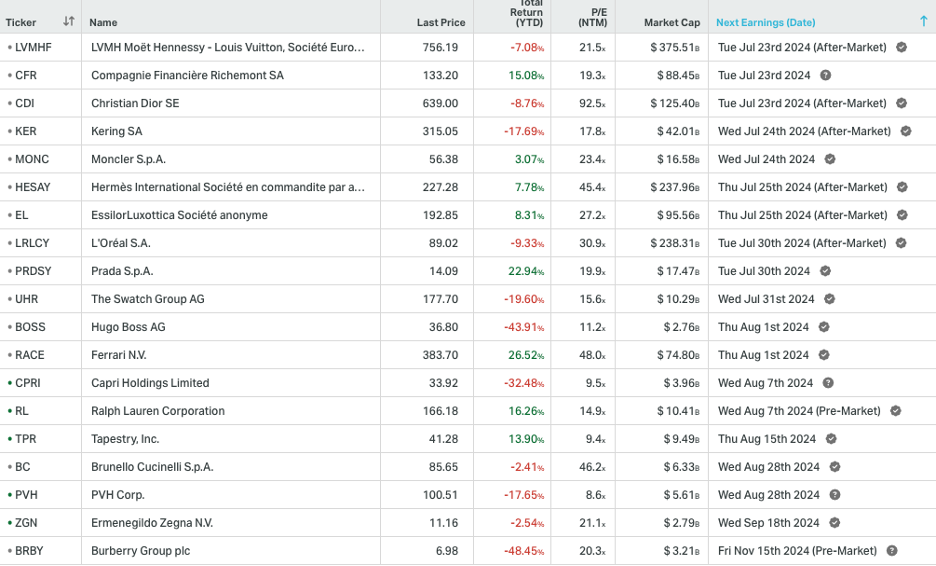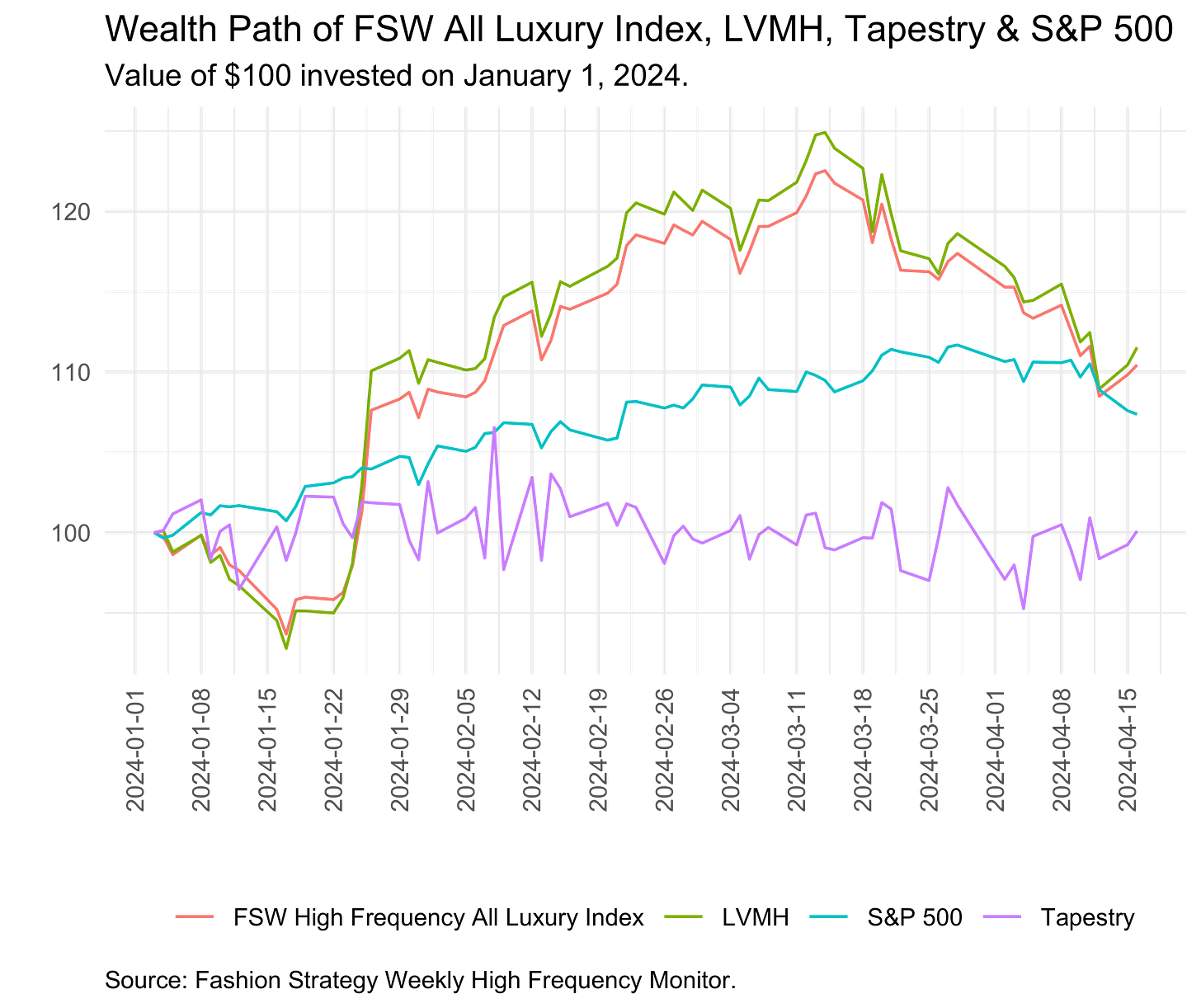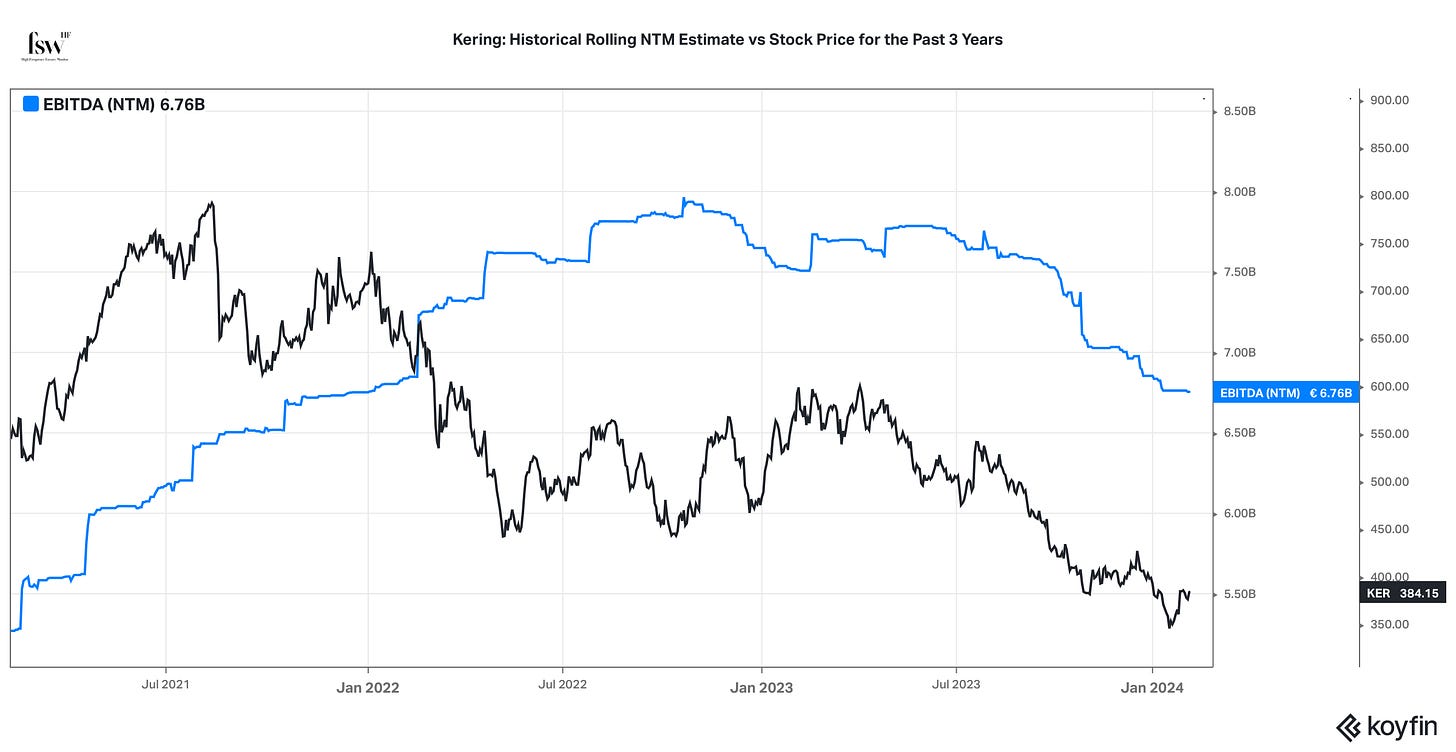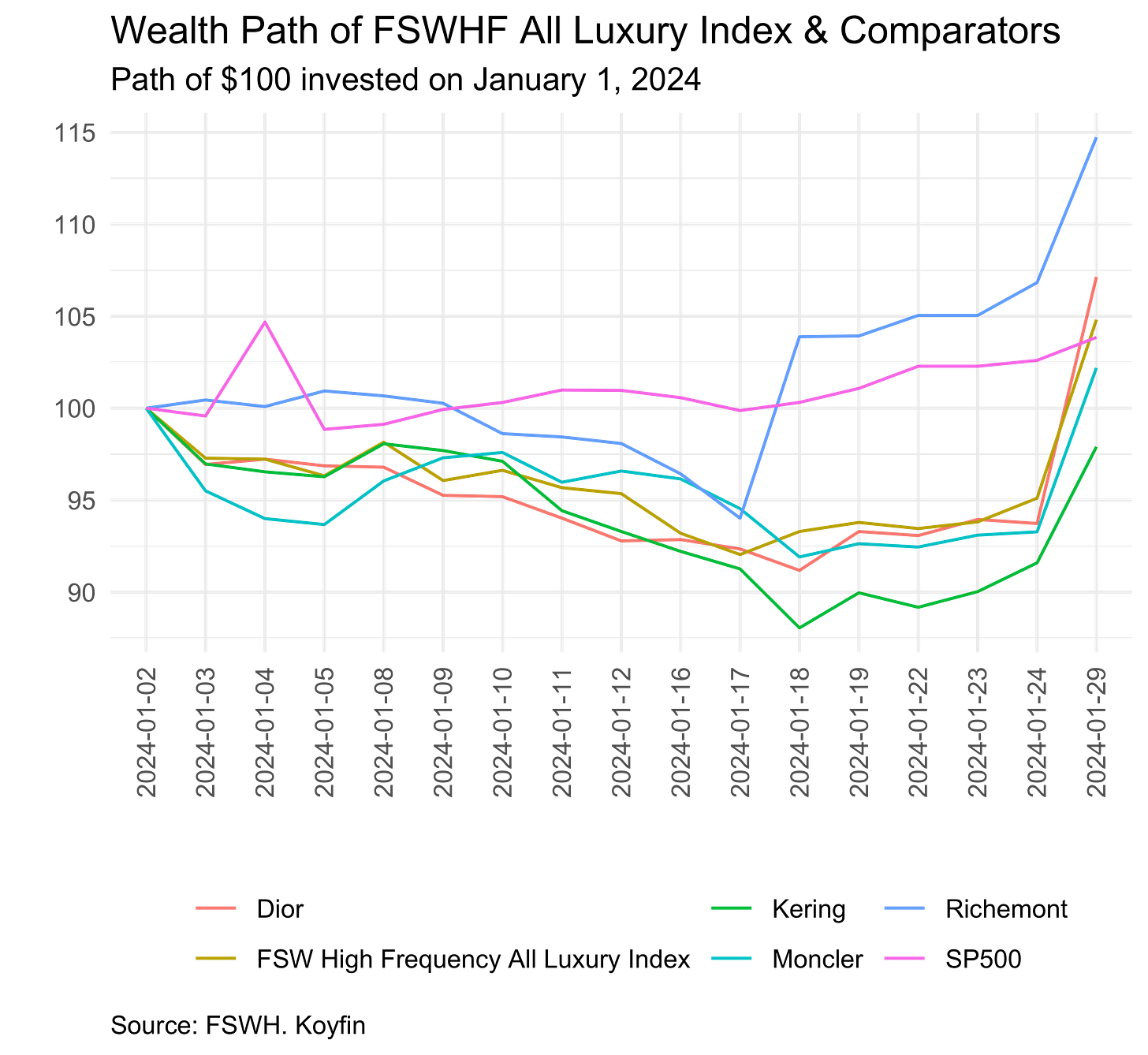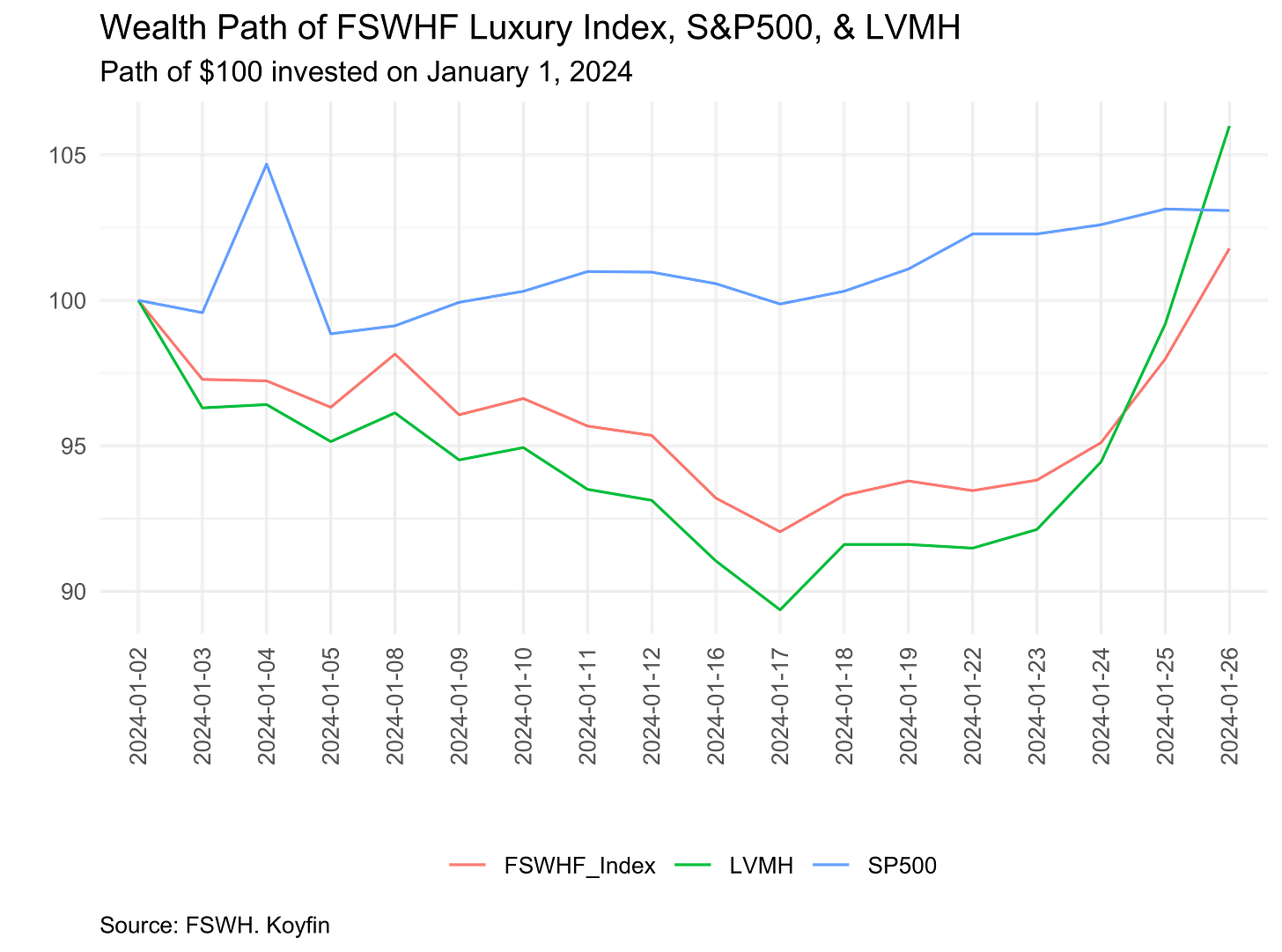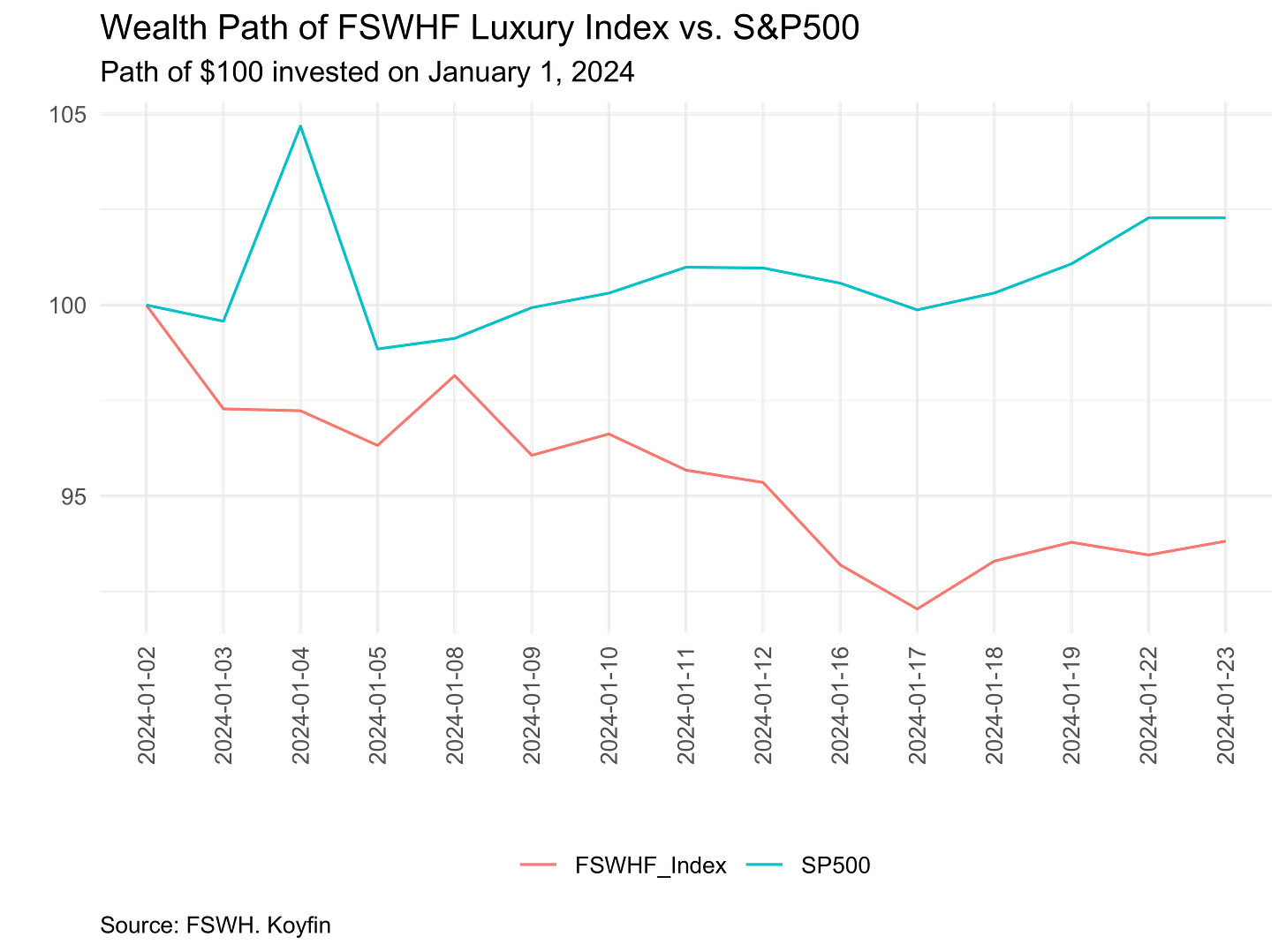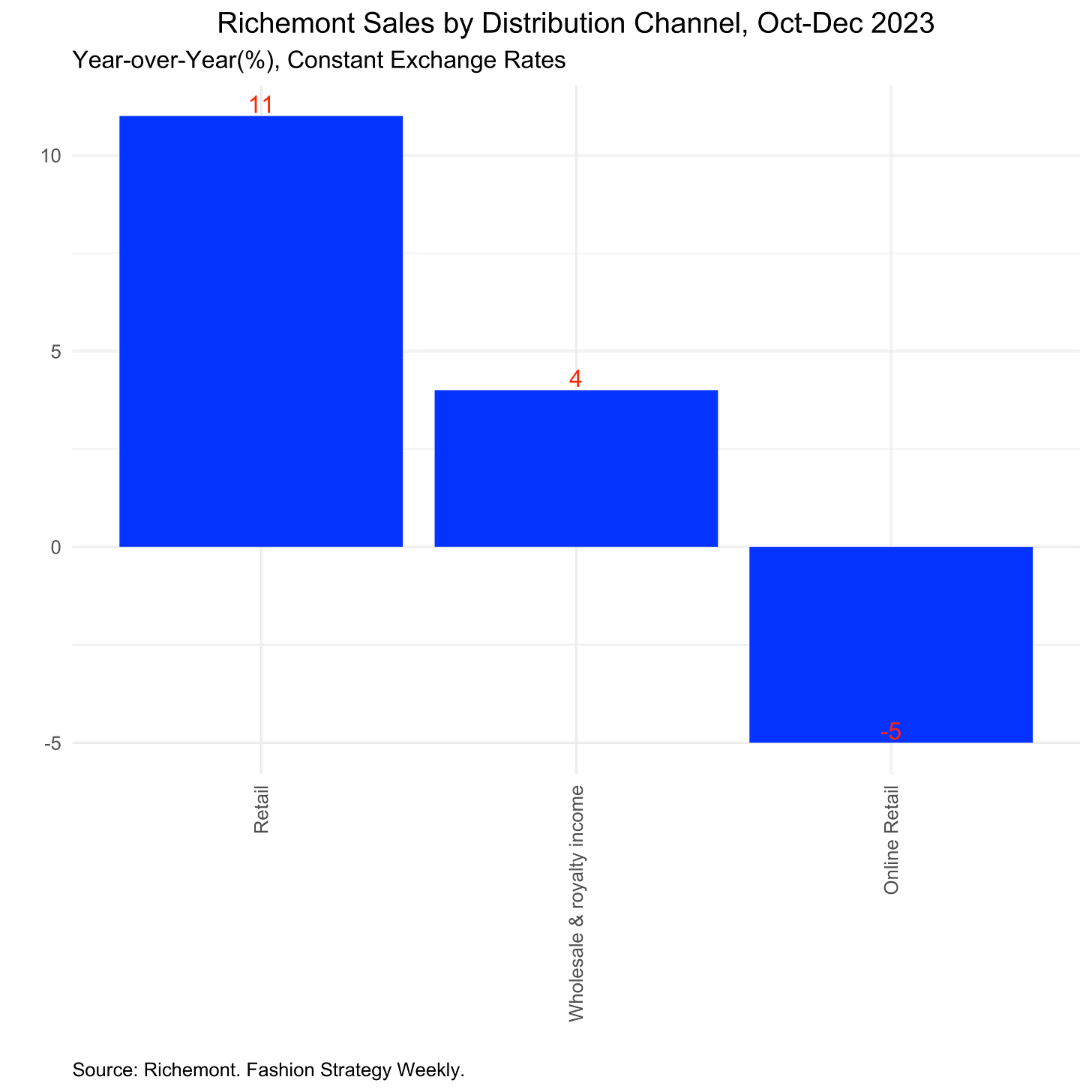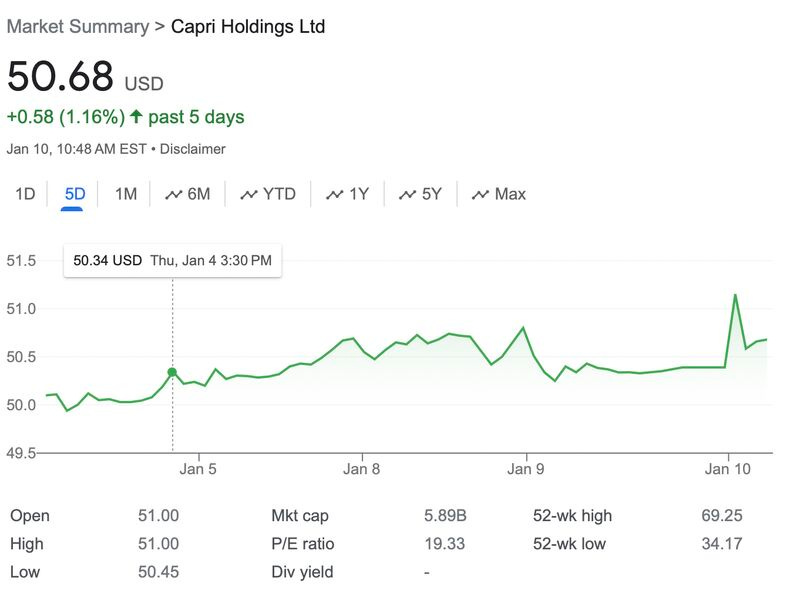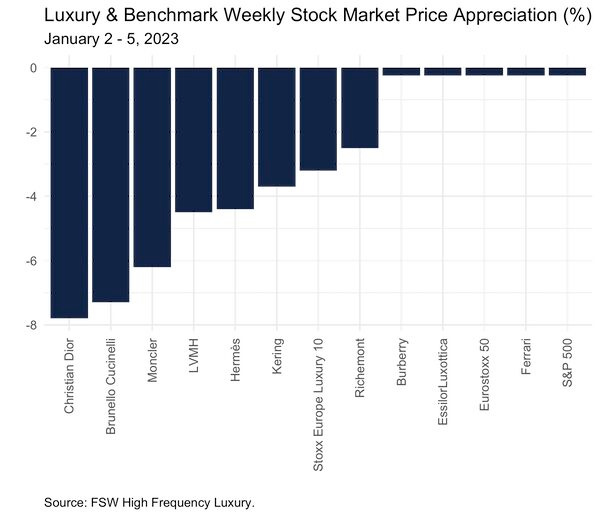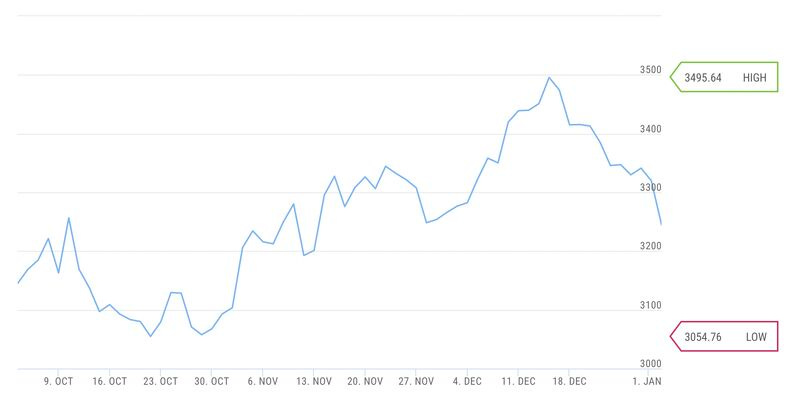FSW Markets
Luxury Share Price Index Up Over 10 percent As We Enter Q4
As we start the fourth quarter, below is a snapshot of the state of luxury share price trends so far this year.
🔘 Our FSW Markets All Luxury Index is up 10 percent year-to-date as compared with 13 and 12 percent gains for the Euro Stoxx 50 and S&P 500, respectively. The three indexes have recorded almost identical linear returns though arrived in that spot through different paths.
🔘 Luxury prices reached an annual peak of over 20 percent growth in Q1, driven by expectations of a return to sales growth, but then declined in April as actual earnings reports fell below expectations. The S&P, by contrast, has staged a solid rally since April after a sharp slide during Q1.
🔘 This comes as the industry recorded its sixth consecutive quarter of negative revenue growth. Our cap weighted index put the industry at -4 percent y/y growth in H1 though diversity in cross-brand performance was near a historic high as we discuss in our latest Fashion Strategy Weekly (https://lnkd.in/ejQs7xEC)
🔘 A 60+ percent surge in Kering’s share price since April has helped drive the overall industry index on hopes that Luca de Meo can steady the ship at Gucci.
Luxury Brand Performance Differentiation at Historic High
September 22, 2025
It is now pretty widely reported that luxury sales, particularly ‘soft luxury’, have cooled off from the breakneck growth experienced during the industry-wide super cycle that followed the pandemic. Some of the industry’s biggest names are reporting some historically bad numbers. However, industry averages (or medians) mask another trend: a sharp increase in performance differentiation across luxury brands and product categories. If you like, average growth is slowing but the standard deviation of the industry’s performance is rising. There are some losers but also some remaining winners.
Let’s start by identifying which brands continue to win with consumers. Here, we looked at a large sample of earnings reports, readily available on company websites for public companies, for luxury fashion, jewelry, watches, cosmetics, and fragrance brands. We are excluding some other major verticals, such as eyewear, travel and wellness, and automobiles, for several reasons. In many cases, these brands have characteristics that make comparison with others in our sample difficult, and we can conduct a separate analysis later on that relies less on large-sample (Large-N) comparisons at a later stage.
Below we show annual revenue growth for the period of April to June 2025. (You can find our analysis for the full year 2024 and January to March 2025, which provides a similar comparison.) We cover 24 different public brands or quasi-brands. As LVMH and Richemont do not report individual brand data separately, we pulled out some high-level product categories that are reported: LVMH watches and jewelry, LVMH perfumes and cosmetics, LVMH fashion and leather goods, Richemont jewelry, and Richemont specialist watchmakers. This results in something different than a pure apples-to-apples comparison with the other brands (which themselves may be a mix of different types of products), but this is better than nothing and seems necessary given that LVMH and Richemont represent around 35 and 10 percent of the industry, respectively.
So of our 26 brands, 9 reported positive sales growth during the period of April to June 2025. These brands include Miu Miu, Brunello Cucinelli, Richemont Jewelry Maisons, Coach, Hermès, Stone Island, Ralph Lauren, Church’s, Tom Ford Fashions, and Zegna. The rest of the industry recorded negative growth with three brands (Stuart Wietzman, Thom Browne, and Gucci) recording 20+ percent declines in annual growth during the same period.
At the industry level, luxury remains in recession. The plot below shows annual revenue growth for a weighted index of major luxury organizations. The plot displays a fairly lengthy time series that encompasses semi-annual growth before, during, and after the pandemic, and includes the It’s A Working Title LLC industry forecasts for the period from H2 2025 to H2 2026. The industry has reported negative revenue growth for about six consecutive quarters. By our count, the only other instance of this occurrence was during and after the 2008 global financial crisis. This is a historically unique slowdown.
Yet, as we saw in the revenue numbers for the latest quarter, the slowdown is not universal. In fact, there has never been a period in recent history when performance by luxury brands has been so heterogeneous. To get a sense of the heightened level of dispersion in performance, we created a violin plot below, which illustrates how luxury firms’ revenue growth was distributed across the industry from 2017 to the latest results in 2025. The vertical axis shows revenue growth in percentage terms for the luxury firms in our sample, while the width of the “violin” indicates the number of firms with results at that level. Taller, stretched violins indicate that firms’ performances were more scattered, while shorter, wider ones suggest they were more similar. The violin for the last two quarters is the longest over this nine-year period of time, and the thinness shows that there is relatively low clustering of similar results.
In fact since the pandemic, the volatility of luxury revenue growth has risen dramatically. Some standard measures of statistical variance point to this trend. The standard deviation of revenues, which shows the absolute spread of results, jumped from about 8–10 percentage points before 2019 to regularly above 20 and even into the 40s in recent periods. The coefficient of variation, which measures volatility relative to average growth, has spiked erratically since COVID—rising from around 0.7–1.0 before 2019 to levels above 2.0 and even near 4.0 in some recent half-years—showing that even strong years came with unstable performance. Meanwhile, the interquartile range—the spread between the middle 50 percent of firms—has widened from roughly 5–7 percentage points in the late 2010s to more than 12–13 percentage points after 2020, signaling that dispersion is no longer confined to a few outliers but now affects the core of the industry.
Content Strategy Can Act as a Tool of Risk Management for the Luxury Industry
June 23, 2025
The only certainty so far this year is persistent uncertainty. This is always true to a degree, but our clients report feeling the weight of the unknown more in their short-term and medium-term planning over the past three months than in the past few years since the pandemic.
Our near-term forecasts for luxury industry sales remain pretty tepid given slowing consumer demand in, well, most of the industry’s key markets. We now expect sales growth to be 3 percent lower this year than last and to decline by around 0.5 percent in 2026. This looks pretty ugly when compared with the 14 percent average annual growth rate in the five years prior to the pandemic, nevermind the 27 percent average growth in the post-pandemic super cycle years of 2021-23, underpinned by decent volume growth and enormous price increases (you can listen to my recent discussion with Sanja Bećirović about recent pricing dynamics: https://lnkd.in/eDqG_wBi).
And the risks to the luxury sales environment appear to be tilted to the downside, as the cool forecasting kids like to say. Last week, the World Bank knocked 0.7 percentage points off its global forecast for 2025-26. China is now expected to see a steady decline in economic growth from 5.0 percent last year to 4.5 percent this year, and 4.0 percent over the next two years. Growth in the U.S. is expected to fall from its recent rate of around 3.0 percent to around 1.5 percent for a while.
But not all is doom and gloom. Historically, the luxury industry has proven fairly resilient during previous economic slumps, with a significant share of sales (maybe as much as 40 percent) anchored by buyers whose luxury purchase decisions may be relatively inelastic. And indeed, even in the current environment not everyone is struggling.
We observed some brands achieve decent sales growth in Q1 and the market’s expectations of future cash flows appear decent for many names, reinforcing the substantial market divergence that we observed last year. Our FSW Markets cap-weighted industry index is up about 8 percent year-to-date (vs. ~2.5 percent for S&P 500 and ~9.5 percent for the Euro Stoxx 50) with half of the index’s constituents up on the year.
What drives the wedge between the winners at the losers in this environment? The story up close is of course, complicated and the model messy, but take a step back and many of those doing well are successfully projecting their brand story across all of the digital and IRL customer touchpoints.
Using recent data, we found a positive correlation between hitting KPIs and exemplifying a strong content strategy. Quality products are essential. A brand story is important. However, implementing a content strategy, underpinned by effective content operations, helps deliver enduring results in both good times and bad. You can read our latest report on the topic.
Luxury Stock Prices Surge Over 15% from Trough though Sales Forecasts Remain Grim
May 7, 2025
Asset prices have recovered a fair amount of the ground they ceded after the launch of broad-based tariffs by the U.S. on April 2. However, a wave of optimism (justified or not) has swept through markets over the past couple of weeks on hopes that we are past peak policy uncertainty. After a strong start to the year, the S&P 500 is now just down around 4 percent YTD after hitting a trough of -14 percent in mid-April. The Euro Stoxx 50, which remained much more resilient than U.S. indexes, is now up almost 8 percent. The VIX sits at 24 after peaking at 49. Policy actually remains as uncertain as ever, which continues to depress the dollar and power demand for gold, but we seem to be at least taking a small break from the panic.
Our FSW Markets All Luxury Index is now up 11 percent on the year. Like other asset classes, luxury stocks have been on a rollercoaster. Our 18-company, cap-weighted index was up over 20 percent in February on hopes that 2025 would produce a better year for the industry, underpinned by strong U.S. growth, making up for persistently weak demand onshore in China. The bursting of those hopes drove the index down to a 3 percent decline by early April. At the moment, the index has recovered about half of its post-tariff losses and is up 11 percent.
Eight of the index’s 18 company constituents are up on the year. This list comprises: L’Oréal, Hermès, EssilorLuxottica, Moncler, Tapestry, Richemont, Ferrari, and Ralph Lauren. Industry bellwether LVMH (which has again passed Hermès as the largest public luxury organization in the world by market capitalization) is down over 20 percent, having failed to make up any ground after reporting a 2 percent dip in Q1 revenue.
Despite some bounce back in investor sentiment, forward guidance remains grim. Our own FSW Markets forecast is for a 5 percent decline in full-year sales growth. This forecast is down from our January 2025 vintage, which was for a 4 percent increase over last year. The industry contracted 4 percent last year following years of strong, post-pandemic growth well above historical norms for much of the industry.
FSW Markets All Luxury Index Finishes Up After Volatile Week
April 14, 2025
The FSW Markets Index was on the same roller coaster ride as the rest of the equities universe last week. The index closed up 4 percent from April 4 to 11, reflecting a big recovery after closing down 4 percent during the early part of the week. Eleven of the index’s fourteen constituents finished up on the week, led by Hermès, PVH, and Capri Holdings. Prada was up around 1 percent on the week after they announced a 1.25 billion acquisition of Versace.
You can read our commentary on the Prada-Versace deal in Vogue Business: https://www.voguebusiness.com/story/companies/whats-happening-with-the-prada-versace-deal or see our interview on CNN International with Richard Quest:
When the correlations all go to 1
Our FSW Markets All Luxury Index was up almost 25 percent in mid-February. Currently, it is down around 2 percent. As of intraday today, most of the index’s constituents are down on the year with a few exceptions: Hermès (4.0%), EssilorLuxottica (2.6%), and Moncler (0.82%).
In the past week, we have downgraded our luxury industry growth forecasts by around 6 percentage points from the February forecast to -2.5 percent year-over-year. Of course, this point forecast is based on anyone's best guess on the macroeconomic environment that will take root for the remainder of the year, and the interval forecast would be quite wide.
Another strong week for luxury equities
February 17, 2025
The FSW Markets All Luxury Index closed up almost 7 percent last week. Outside of small declines from Burberry and PVH Corp., every constituent of the index was up on the week and most of them big.
The biggest gainer was Kering. On Tuesday, Kering announced that its full-year 2024 annual revenues were down 12 percent, with recurring operating income down 46 percent, and gross margins collapsing from 24.3 percent in 2023 to 14.9 percent (vs. an industry average of 30 percent). And yet, the market believes that it is finally looking at the trough despite or because of CEO turnover at Gucci, YSL, and BALENCIAGA and the removal of Sabato De Sarno.
Hermès closed up over 7 percent after issuing yet another strong earnings report. On Friday, Hermès revealed that annual revenue reached €15.2 billion, a 15 percent increase at constant exchange rates, and a net profit of €4.6 billion, representing 30.3 percent of sales. Growth was everywhere you could look in all geographies and all product lines apart from watches. Hermès' share price is up almost 25 percent on the year, and its market capitalization has now exceeded €300 billion.
This strong week pushed the FSW Markets All Luxury Index up over 20 percent for the year as compared to a roughly 4 percent gain for the S&P 500, which is within 1 percent of an all-time high despite the fact that the January CPI print pointed to stubborn inflation that pushed back market expectations for another interest rate cut. The Euro Stoxx 50 (of which about 10 percent is luxury) closed up over 3 percent amid some positive earnings numbers. In China, the CSI 300 closed up just over 1 percent despite continued fears over the trajectory of tit-for-tat tariffs with the U.S. and more bad news out of the property market.
In the coming week, we will get a look into consumer confidence and retail sales in the UK, the FOMC will release its latest minutes, and we get the countdown to the German national election on February 23.
Another strong Hermès earnings report points to the dispersion in the global luxury market
February 14, 2025
When scrolling the luxury news during the past few earnings seasons, it is becoming increasingly less remarkable to see the latest autopsy of a global luxury crisis followed by deep dives into the income statement of Hermès that use words like “remarkable” and “resilient.” February 14 was one of those days. Many industry watchers will again be pulling out positive adjectives to describe Hermès’ newly released full-year 2024 results and may also be hoping to receive an orange box with brown trim in their Valentine’s Day stash.
Hermès’ 2024 financial results showed the brand delivering more exceptional growth with annual revenue reaching €15.2 billion, a 15 percent increase at constant exchange rates, and a net profit of €4.6 billion, representing 30.3 percent of sales. Growth was everywhere you could look in all geographies and all product lines apart from watches. Demand from China was noted to be softer but Asia (x. Japan) sales were still up 7 percent with strong growth recorded in Japan (23 percent), Europe (19 percent), and the Americas (15 percent). Product categories such as leather goods (+18 percent), ready-to-wear (+15 percent), and jewelry/home collections (+17 percent) performed well, while watches saw a slight decline (-4 percent) due to a high comparison base. While we read a lot about luxury having weaker pricing power after misusing it for so many years, Hermès remains confident in its pricing strategy (+6-7 percent increase for 2025) and its ability to maintain exclusivity and desirability in the luxury market.
So far this earnings season, most industry central tendency measures of sales growth such as average or median growth have softened, yet the standard deviation has risen.
In the below, I pulled out the earnings for four of the industry heavyweights and indexed them to 2018 level so that we could see some evolution from before, through, and after the pandemic. Coming out of the pandemic, most of the industry realized explosive growth. That growth continued at rates that exceeded historical norms for many brands with Kering a notable exception as poor sales at Gucci began to pull down in 2023 when much of the rest of the business was still growing over 10 percent a year and maintaining strong margins.
Yet, 2024 has been a year of a mini structural break. We were already seeing quite a bit of industry dispersion in 2023, but this year the variance really stands out now that LVMH (about a third of luxury fashion revenues) tipped slightly down.
Market yawns as Kering reports more terrible results
February 11, 2025
🔘 Kering has been the sick man of the luxury for a while now. Their participation in the post-pandemic luxury top-line growth party was substantially less than that of many of its competitors (e.g., revenue growth in 2021 was 10 percentage points lower than LVMH) and the revenue buying glow faded faster with Kering reporting negative sales growth in 2023 when the rest of the industry was still growing. In the last year, there has been CEO turnover at Gucci, YSL, and BALENCIAGA. And let us not forget that Sabato De Sarno left Gucci last week after less than two years. As an instinct, I normally write that Gucci comprises about half of Kering’s group revenues. But, after a 23 percent collapse in FY24, Gucci now kicks in 44 percent.
🔘 It is a sign of Kering’s times when the market mostly shrugged off today’s results. As of the time of writing, Kering’s intraday share price is actually up over 100 basis points, lifting its YTD by 3.4 percent. This is well below the 13 percent gain for our FSW Markets All Luxury Index, but it shows that the market mostly expected today’s results and perhaps was somewhat cheered by the dedication to make FY25 a year of stabilization.
🔘 So how low did it go? Revenues were down 12 percent year-over-year when recurring operating income was down 46 percent. Operating margins collapsed from 24.3 percent in 2023 to 14.9 percent last year. Looking at the decomposition of gross margins, top-line growth was down 12 percent, gross margin rate (revenue remaining after subtracting the costs of goods sold) was down 2 percent, FX/hedging was down 3 percent, while scope was up 2 percent, which presumably was due to the continued integration of Creed into the Kering portfolio. However, these margins really stand out in an industry where operating margins typically fall in the 25-35 percent range. Free cash flow was down 27 percent (though this looks better if you exclude real estate transactions), while net financial debt rose almost 25 percent with acquisitions of buildings in New York and Milan.
🔘 Much has been written about what has gone wrong at Gucci and Kering and what it will take to return to industry norms. Today’s report leaned heavily into FY25 being about stabilizing the income statement - in effect, hitting a trough. We will see.
You can find the full report here: https://lnkd.in/emf9sUzb
You can reach how we ranked Kering brands against competitors in content effectiveness in our 2025 industry preview here: https://lnkd.in/gEesD7eJ
Ralph Lauren and Tapestry release strong sales numbers that underline the importance of content effectiveness in an increasingly diffuse luxury market
The dispersion story continues in luxury fashion as more end-of-2024 earnings numbers roll in. Tepid results from LVMH on January 27 led to a small luxury market sell-off, but earnings numbers from Ralph Lauren and Tapestry today show that it is not all doom and gloom.
On February 6, Ralph Lauren reported blowout results for the period of October to December, which showed an 11 percent increase in their third-quarter revenue, reaching $2.1 billion, up from $1.9 billion in the same quarter the previous year. This growth was driven by increases across all reportable segments despite unfavorable foreign currency effects. The company achieved a gross profit of $1.5 billion, with a gross margin of 68.4 percent, up from 66.5 percent in the prior year. Notably, revenue growth in China was in excess of 20 percent and fairly balanced across geographies. This allowed Ralph Lauren to lift their full year FY25 forecast to 6-7 percent.
Tapestry, the parent company of Coach, kate spade new york, and Stuart Weitzman, reported a 5 percent year-over-year increase in second-quarter revenue, totaling $2.2 billion. This growth was primarily driven by a 10 percent increase in Coach sales, attributed to the popularity of items like the Tabby and Brooklyn bags, which have resonated with Gen Z consumers. Over half of the 2.7 million new North American customers acquired by Tapestry in Q2 were Gen Z and millennials. In contrast, sales at Kate Spade and Stuart Weitzman declined by 10% and 16%, respectively. Tapestry, presumably meaning Coach, also recorded positive growth in China at 2 percent on a constant currency basis. The company achieved a gross profit of $1.6 billion, representing a 9.4% increase, supported by operational improvements and reduced freight costs. Tapestry raised its full-year 2025 earnings per share outlook to $4.85 to $4.90, up from the prior guidance of $4.50 to $4.55, and now anticipates revenue of over $6.9 billion, representing approximately 3 percent growth.
Intra-day trading in New York sees Tapestry up over 12 percent and Ralph Lauren up over 9 percent, implying YTD price appreciation of over 25 and 17 percent, respectively.
As we argued in our 2025 luxury industry preview (https://lnkd.in/djJwqbaG), brands with effective content strategies, like Ralph Lauren and Tapestry, continue to deliver strong results. This strengthens the thesis that the luxury market is not in decline as much as it is experiencing extreme dispersion. Brands that can connect with consumers with effective stories and offer seamless digital shopping experiences are winning with consumers. Note the positive correlation between sales growth and the Fashion Strategy Weekly content effectiveness index, produced by staff at It’s A Working Title, LLC®️, below.
Amid mixed 2024 earnings reports, investors’ confidence in luxury has taken a beating in the past week
Luxury industry earnings reports have been a bit mixed over the past week as the full year 2024 numbers rolled in. Richemont, Ferrari, and Zegna punched above analyst expectations while LVMH was sort of half hot and half cool.
In the midst of these reports, investors’ confidence in a bounceback for the industry this year has turned south. As the below line plot exhibits, our FSW Markets All Luxury equity index came out of the gate quickly in January, but earnings reports combined with fears over the impact of U.S. tariffs on the mostly Europe-based luxury industry has taken its toll. On January 27, the index was up almost 21 percent for the year while bellweather LVMH was up 25 percent. Since then, both have lost about 10 percentage points. This still puts the industry above benchmarks such as the S&P 500 and Euro Stoxx 50, but the trend is not going in the right direction as more earnings reports are released.
Though we are still waiting for more 2024 results, it seems likely that the industry suffered its first negative annual growth rate last year if we exclude years impacted by the GFC and Covid. We continue to forecast a weak H1 2025 followed by a small bounce back in H2. You can find our forecasts here: https://www.fashionstrategyweekly.com/p/lvmhs-full-year-2024-results-point
Looking at the markets intraday, Capri Holdings Limited is down almost 13 percent today after reporting a $547 million net loss for the period of October to December, primarily due to a non-cash impairment charge of $602 million. On an adjusted basis, earnings per share were $0.45, falling short of analyst expectations of $0.66. Revenue decreased by 11.6 percent year-over-year to $1.26 billion, with declines across all major brands: Michael Kors' revenue in the Americas declined by 10 percent while Asia experienced a 27 percent drop. Both Versace and Jimmy Choo reported sales declines during the holiday quarter. Looking ahead, Capri forecasts fiscal 2025 revenue of $4.4 billion and fiscal 2026 revenue of $4.1 billion, both below Wall Street estimates, indicating a slow recovery in luxury goods demand.
FSW Markets Weekly Roundup: Luxury Industry Retreats for the First Time this Year after LVMH Results and Looming Tariffs
Our FSW Markets All Luxury Index was down 6 percent over the past week, following a sharp decline in LVMH after releasing its full-year 2024 earnings report on January 27. Half of the index’s 18 constituents were down as LVMH was joined by Ralph Lauren, Tapestry, Kering, L'Oréal, PVH Corp., Capri Holdings Limited, and Moncler, which were roughly down 2 percent for the week.
The index remains up 14 percent for the year compared to a 2.3 and 8.6 percent return for the S&P 500 and the Euro Stoxx 50, respectively. However, the market’s reaction to LVMH’s earnings report will be cautionary for the industry as we continue to wade into further 2024 earnings reports. As we discussed in our review of the LVMH report (https://www.fashionstrategyweekly.com/p/lvmhs-full-year-2024-results-point), there were some positives and negatives to read into its 2024 results.
One negative that stands out more prominently now than it did mid-week is the possibility that hopes that growth in U.S. sales would be able to fill some of the gap left by Chinese consumers could be misplaced. For LVMH, sales in Asia (excluding Japan) were down 11 percent, while U.S. sales were up 2 percent. However, the rollout of broad-based and untargeted U.S. tariffs against Canada and Mexico last week will send a shiver down the spine of the luxury industry. The U.S. administration has suggested that tariffs against the EU are coming, prompting a promise of retaliation from Europe.
This is bad news for the luxury industry and Europe more broadly. Triangulating among a variety of sources, luxury products account for around 5-8 percent of European exports to the U.S. The American market represents about 25 percent of the global demand for European luxury organizations, and this percentage has been growing.
In other news, in the past week, U.S. GDP grew at 2.3 percent in Q4 and 2.8 percent for the full year, slightly below consensus forecasts but ahead of long-run forecasts. The European Central Bank cut rates by 25 basis points to 2.75 percent amid continued weak eurozone growth. News continued to be poor out in China as PMI data pointed to worsening conditions across manufacturing, services, and construction.
In the week ahead, we will get an interest rate decision from the Bank of England, further PMI data from China, and a U.S. inflation report.
Luxury share prices surging ahead of LVMH's full-year 2024 earnings release on Tuesday
The FSW Markets All Luxury Index is up over 14 percent this year. This compares with a nearly 10 percent decline in 2024. Fifteen of the index’s eighteen constituents are up, led by Richemont (up around 25 percent YTD) after their strong Q3 report, Burberry (up around 18 percent) after a better-than-feared full-year 2024 report and enthusiasm for its new strategic direction. Industry giant LVMH, which comprises around a third of luxury fashion revenues, is up over 17 percent as investors hope that the doom and gloom surrounding the industry last year has begun to lift as hopes that American consumers will help fill the void left by China’s luxury shoppers.
Part of the story on the equity side is a generally strong Europe so far this year. The Euro Stoxx 50 is up over 6 percent, while the Paris CAC-40 is up closer to 8 percent. It is well worth noting that luxury is a big constituent of European exchanges, kicking in about a third of the CAC’s value.
After Paris closes on Tuesday we will get a major industry barometer for holiday sales success as LVMH will report its full-year earnings. Analysts have set cautious expectations for LVMH's upcoming full-year and fourth-quarter 2024 financial results. The consensus anticipates a 1% decline in fourth-quarter sales, with the pivotal fashion and leather goods division projected to experience a 3% decrease. This follows on from a weaker-than-expected Q3 where a 3 percent sales drop disappointed investors who, on the median, predicted a 1 percent increase.
The FSW Markets industry forecast is still for a 5 percent industry contraction in full-year 2024, followed by a 1.7 percent gain in full-year 2025 with a weak H1 2025.
You can find the Fashion Strategy Weekly 2025 year-in-preview here: https://lnkd.in/eXQWXGmW
Luxury Strikes Back as Luxury Earnings Season Kicks Off
The start of the year looks, for a potentially brief moment, like a reboot for luxury after some strong earnings releases from Brunello Cucinelli and Richemont over the past week. The sour mood surrounding the retail luxury industry, particularly luxury fashion, for the past six months or so may lift for at least a bit after Brunello Cucinelli announced full-year 2024 revenue growth of 12.4 percent with strong growth across all geographies, including China. This was not a total shock as Brunello Cucinelli was among the strongest performers in a year when dispersion in sales growth was the theme of the first nine months of the year.
However, Richemont surprised investors by posting a strong Q3 (October to December on the fiscal calendar) of 10 percent growth, implying a 4 percent growth rate during the first nine months of their reporting year. Like many of the larger luxury groups, sales were weak in Asia Pacific (down 7 percent, comprising about a third of sales) during the quarter, with growth powered by ~20 percent growth in the Americas (24 percent of sales), Europe (23 percent) and MENA (0.08 percent).
These results powered optimism for luxury in financial markets. Our cap-weighted FSW Markets All Luxury Index was up 17 percent on the week and is now up almost 20 percent on the year. Luxury represents about a third of the Paris CAC-40 and that index was up 2.8 percent on the week and 4.5 percent on the year. This compares to a 2 percent return for the S&P 500 and 1.4 percent decline for the SPDR S&P Retail ETF (XRT) this year. Industry titan LVMH, which kicks in about a third of global luxury fashion revenues, has at least briefly regained its crown as the largest company in Europe from a slumping Novo Nordisk.
It is unclear to what extent this past week’s results are a leading indicator for the rest of the industry as we wade further into the full-year 2024 earnings season. Richemont’s sales are dominated by its Jewelry Maisons division, including Cartier and Van Cleef & Arpels. This division represents almost three-quarters of group revenues and was up 14 percent for Q3. So, groups with heavier exposure to soft luxury and aspirational consumers may struggle. For what it is worth, Richemont’s “Other” division, which includes fashion and accessories brands, such as Chloé and Maison Alaïa, was up 11 percent for the quarter even though they are a small part of the Richemont pie.
In global macro news that impacted the industry last week, China’s Q4 GDP growth print beat expectations at 5.4 percent. However, recent private consumption numbers do not point to a near-term rebound. U.S. CPI came in at 2.4 percent, countering fears that we may see more hikes.
Coming up this week, we will see some economic activity indicators out of Europe on Friday. Most critically, we will see what the first few days of the Trump administration bring regarding tariffs and other announcements.
Brunello Cucinelli Reports Industry Beating 2024 Revenues
Brunello Cucinelli continues to outperform most of the luxury industry, announcing full-year 2024 revenue growth of 12.4 percent (constant exchange rates) on January 13. With much of the luxury industry slowing from the rapid rates of growth experienced during the post-pandemic supercycle, Brunello Cucinelli has been one of those brands that has continued to grow.
Most of the luxury fashion industry has been pulled down by weak growth in Asia, but Brunello Cuccinelli was among the few brands that powered past that trend. Its revenue growth in Asia, which comprises about a third of total revenue, was up over 12.6 percent in 2024, second only to growth in the Americas at 17.8 percent.
After the brand experienced unprecedented post-pandemic growth in 2021, its owner, Brunello Cucinelli, told Vogue Business, “We do not wish to grow fast. Rapid, sudden growth isn’t rational, and it isn’t sustainable. It creates problems.”
Regardless, in a year in which we have seen differentiation across the luxury industry after several years of broad-based growth, Cucinelli has grown fast. The figure below exhibits semi-annual revenue growth rates for Cuccinelli, reflecting Monday's data release, and the FSW Markets forecast for the rest of the industry.
You can read Brunello Cucinelli's 2024 full-year earnings release here: https://lnkd.in/eyhg4EQx
You can read our views on why Brunello Cucinelli has been one of the year's top performers in a recent Fashion Strategy Weekly post here: https://lnkd.in/e6dvEbZD
The New Year Brings Key Macro News for the Luxury Industry
There was a lot of global macro news released during the first full trading week of the year with the potential to impact the retail luxury and premium sector. The FSW All Markets Index is now up 4.5 percent on the year with 14 of the 18 index constituents gaining. The first wave of macro news this year points to a mix of head- and tail-winds for the industry.
The biggest gainers have been Capri (up 17 percent) on rumors that Prada may purchase Versace from the struggling group, Moncler (up 7.6 percent) as extremely cold weather strikes across the U.S., and Brunello Cucinelli (up 5.7 percent) as the brand continues to go from strength to strength. Industry giant LVMH is up 4.6 percent so far this year.
Key macro news for luxury and premium market watchers this week included:
Deflationary pressures in China continue as consumer prices in December were up 0.1 percent while producer prices fell for the 27th consecutive month. This is more bad news for the industry given the role that China has played in powering growth over the past decade. You can find our view and China forecasts here: https://www.fashionstrategyweekly.com/p/forecasting-the-future-of-luxury
Interest rates in the U.S. may be holding steady in 2025. Minutes released by the Federal Reserve reflected a hawkish stance with no significant rate cuts expected this year. The yield on the U.S. 10-year note rose to 4.77 percent, signaling diminished expectations for further cuts that might help spur demand from U.S. aspirational consumers. Yet, countering this is a persistently strong labor market as the December jobs report saw 256,000 jobs added, blowing past expectations for 100,000. The unemployment rate fell to 4.1 percent.
Consumer prices in the Eurozone rose 2.4 percent in December. This was in line with economists’ forecasts, yet expectations are becoming more mixed about ECB plans for 2025 rate cuts. The Euro is down over 1 percent to the U.S. dollar so far this year.
You can find the current annual FSW Markets luxury industry forecasts here: https://itsworkingtitle.com/what-lies-ahead-for-luxury-in-2025/
What lies ahead for luxury in 2025?
January 6, 2025
As was widely anticipated a year ago, the retail luxury industry saw the end of the post-pandemic supercycle in 2024. Despite reasonable global economic growth and positive “wealth effect” contributions from generally good global equity market performance, luxury sales slowed across most product categories. In the first nine months of the year, annual luxury fashion and jewelry revenues were down about 3 percent, fine wine and spirits were down around 10 percent, and collectible automobile sales were flat. Our FSW Markets All Luxury equity index was down 10 percent in a year when the S&P 500 was up 23 percent.
The reasons for this slowdown have been fairly well understood. There has been slower demand by Chinese consumers both onshore and offshore. Middle-class consumers across all geographies have slowed discretionary spending with economy-wide higher prices. Double-digit luxury price increases have put off even some normally price-inelastic consumers. We should also add the importance of good old base effects after three years of strong growth underpinned by post-pandemic revenge consumption.
So, how big is the slowdown so far? Going back to 2004, there have been six years of annual decline in luxury sales: 2004, 2005, 2008, 2009, and 2020. Yet, since the global financial crisis in 2008, there has not been a decline in annual sales until the pandemic year in 2020. But the post-pandemic bounce was historically unique. The average yearly revenue growth from 2010 to 2019 was 11.6 percent. Yet growth in 2021 was almost 50 percent, followed by 24 percent growth in 2022. After such breakneck growth, it is hardly a wonder that growth slowed to around 9 percent in 2023 (just below the recent historical norm) and was down around 5 percent in the first 9 months of 2024.
So what lies ahead for 2025 and 2026? The FSW Markets econometric model, augmented with AI/ML elements to guard against overfitting, predicts that the industry will experience fairly sharp contractions in H2 2024 and into H1 2025 before experiencing a decent bounce back in H2 and fairly moderate growth into 2026.
Luxury Slowdown Has Been Broad-based in 2024
December 30, 2024
Luxury assets across almost all classes has been poor this year. Despite reasonable global economic growth and good “wealth effect” contributions from generally good equity market performance across most large economies this year, the post-pandemic supercycle has slowed on everything from luxury fashion to jewelry, watches, art, wine, and automobiles.
As the figure below illustrates, a snap shop of some specifics includes:
Fine wine has lost about 10 percent
Diamond prices were down by 29 percent
Collectible car prices were flat
Our FSW Markets All Luxury Index is down almost 10 percent
The explanations for the end of the supercycle have been pretty consistent over the course of the year: slowing demand by Chinese consumers both onshore and offshore, as we discussed in this issue of Fashion Strategy Weekly (https://www.fashionstrategyweekly.com/p/forecasting-the-future-of-luxury) and a drawdown in demand from “aspirational” consumers unable or unwilling to keep up with the 54 percent increase in luxury prices over the past five years amid rising costs for necessities. Further, The Economist notes strong performance of equity markets and even crypto (Bitcoin is up over 120 percent YTD) this year means that the opportunity costs of investing in luxury (for those who treat it as an asset class rather than a passion project) have been high. (https://www.economist.com/finance-and-economics/2024/12/27/why-fine-wine-and-fancy-art-have-slumped-this-year)
Many believe that 2025 may be better than 2024, yet it is unclear what variable that pulled down growth in 2024 looks more positive 2025 based on near-term forecasts. But, of course, most forecasts tend to be grounded in a mathematical or mental model that is effectively some extrapolation of the most recent past, so in short, things change.
The biggest takeaway for any brand in these broad-based asset classes is that while all brands are subject to the same macroeconomic environment, only some have unveiled innovative holistic brand content strategies that deeply resonate with a commitment to luxury brand storytelling. This year's most successful brands have tended to feature content strategies that represent an on-brand, well-thought-out plan that perfectly shows how content and technology can work together to bring a more authentic approach to digital customer experience.
We have covered why we think some brands are winning the content, and hence the sales wars this year for Brunello Cucinelli (https://lnkd.in/e6dvEbZD), Loro Piana (https://lnkd.in/eW6VQYhK), and Miu Miu (https://lnkd.in/eCWjKd25).
Luxury assets pullback after their strongest week of the year
December 22, 2024
After recording one of the best weeks of the year, luxury assets were down around 2 percent last week, which was in line with a fairly risk-off five days of trading. Of the 18 constituents of our FSW Markets All Luxury Index, 11 were down on the week, led by Ferrari (-4.6 percent), Kering (-4 percent), and Prada Group (-3.3 percent). HUGO BOSS led the gainers and was up by over 4 percent though Boss remains down by over 30 percent year-to-date. Tapestry continued to gain this week and is now up over 70 percent in a tumultuous year for the group.
Looking at macro news impacting the industry over the last week, China's retail sales rose by 3% year-on-year in November, slowing from a 4.8% growth in the previous month and below market expectations of a 4.6% gain. This marked the weakest growth in retail activity since August. On the other side, retail sales in the U.S. increased 3.8% year-on-year in November, the biggest annual rise since December last year, following an upwardly revised 2.9% gain in October. As expected, the Federal Reserve announced a 25 basis point interest rate cut on Wednesday though the path of interest rate cuts next year looks shallower than that expected a month or so ago.
Macro news will be fairly thin for the remainder of the calendar year. FSW Markets will release its year-end review next week while Fashion Strategy Weekly will post its views on what to expect in retail, luxury, and fashion strategy in 2025 in early January.
To what extent is China pulling down the luxury industry?
December 17, 2024
Luxury is set for its worst sales performance in the last 15 years apart from the pandemic-hit 2020. Yet, the downturn has not been universal, and some brands have continued to perform well, especially those that have continued to succeed in China despite the country’s slowing demand for luxury.
So, how much of the industry's slowdown is due to China? Looking at balance sheet data for a sample of brands to give us a top-down perspective. Revenue growth in China, as we expect, has been weaker than in the recent past.
The below figure looks at the progression of reported quarterly revenue growth in Asia, excluding Japan, over the year. Though these numbers include economies other than China, this is a decent proxy. Included here are two firms that have had positive overall revenue growth this year (Hermès and Prada Group) and two that have experienced a revenue decline (LVMH and Kering). Year-over-year quarterly revenue growth declined across the board, and it was deep and sharp. Even Hermès saw Asia sales slump to near zero by the third quarter after almost hitting 10 percent growth in the first quarter. The only exception was Prada Group, which was underpinned by explosive growth at Miu Miu. (See this Fashion Strategy Weekly post on Prada for our take on what Miu Miu is doing right).
Luxury assets have one of their best weeks of the year
December 15, 2024
Luxury assets had one of their best weeks of the year during December 13-20. The FSW Markets Market All Luxury Index closed up almost six percent. Gainers heavily outweighed losers as 13 of the index’s 18 constituents had positive simple returns during the week: Brunello Cucinelli was up over 7 percent and Zegna, which has had a generally poor 2024, was up over 6 percent. Capri Holdings Limited took the biggest fall of the week, down over 4 percent, amid speculation that they will look to unload Versace and Jimmy Choo after their failed attempt to link up with Tapestry.
But this was an outlier week for the industry, particularly in H2, as the FSW Index is down 5.8 percent year-to-date. This is compared to a nearly 27 percent positive return for the S&P 500, 10 percent gain for the Euro Stoxx 50, and a 15 percent gain for the S&P 500 SPDR Retail ETF (XRT).
Looking towards the week ahead, the Federal Reserve is expected to cut rates by a further 25bp on December 18 as it continues to move policy from restrictive territory to somewhere closer to neutral. We will also see China and U.S. November retail sales released (expected to be fairly flat).
A Look at Brunello Cucinelli
November 25, 2024
In this week's Fashion Strategy Weekly, we analyze Brunello Cucinelli's content strategy after the recent launch of its holiday campaign and considers what the brand's approach to content suggests about the future of luxury experience.
With much of the luxury industry slowing from the rapid rates of growth experienced during the post-pandemic supercycle, Brunello Cucinelli has been one of those brands that has continued to grow. Its July to September revenues were among the strongest in the industry (see below), while its first-half revenues were up almost 15 percent at constant exchange rates.
Most of the luxury fashion industry has been pulled down by weak growth in Asia, but Brunello Cuccinelli was among the few brands that powered past that trend. Its revenue growth in Asia, which comprises about a third of total revenue, was up over 14 percent, second only to growth in the Americas.
After the brand experienced unprecedented post-pandemic growth in 2021, its owner, Brunello Cucinelli, told Vogue Business, “We do not wish to grow fast. Rapid, sudden growth isn’t rational and it isn’t sustainable. It creates problems.”
We know that there is a tension between long-term and short-term growth optimization strategies in the luxury retail space. Bruenello Cucinelli seems to have got the balance about right.
Luxury Suffers Another Poor Week with Some Exceptions
November 17, 2024
Luxury equities had another tough go around last week. The FSW Markets All Luxury Index was down 4.3 percent. This was just over 2 points lower than returns for the S&P 500 and the CAC 40.
There was quite a bit of diversity among top luxury names, however, and the below bar plot shows the five day returns for a number of luxury assets (blue bars) as compared with some benchmarks (red), and the EUR-USD exchange rate (green) is thrown in for good measure.
The industry’s large caps continued to sink over the past week as investors continue to worry about the industry’s cyclical slowdown and are increasingly concerned that it forebodes a structural weakening due, in great part, to weaker demand in China. The titan LVMH was down 3.8 percent on the week and is now down 18 percent on the year while Hermès and L'Oréal were down 3.6 and 4.7 percent, respectively.
On the upside, Burberry’s release of its “Burberry Forward” strategy on Nov 14 led to a 13 percent surge. This took one of the industry’s worst 2024 performers to a mere 0.33 percent decline year-to-date. Lastly, the end of the Tapestry and Capri Holdings Limited tie up was greeted positively by investors this week.
You can read the views of the FSW Markets team on the new Burberry strategy in this November 14 discussion with Glossy magazine.
LVMH Market Share Ticks Down in 2024
November 13, 2024
As we are in the process of updating our year-end and 2025 luxury industry sales and stock price forecasts, we updated our figure on the level of industry concentration.
As the below line plot illustrates, LVMH's share of industry sales has, so far, ticked down slightly this year from 35 to 34 percent given the relatively weak growth that the industry's giant has reported this year.
Yet, overall it is still a picture of a moderately concentrated industry, which is not uncommon in retail sectors. There remains room for competitive pricing and innovation does not appear to be stymied by the current level of concentration.
Having said that, many have noted that the level of industry creativity is flat lining, though it is not clear to us that this is function of industry concentration so much as the impact of structural market pressures (e.g., mainstreaming of e-commerce, creator economy, rising supply chain and manufacturing costs) that has left brands struggling to keep up and differentiate themselves.
What Did the Jul-Sep Earnings Reports Teach Us About the Luxury Slowdown?
November 8, 2024
With a few exceptions, we have come to the end of the latest luxury earnings season, and it was not all doom and gloom. As the bar chart below displays, Prada and Hermès recorded strong double-digit revenue growth (blue bar) that exceeded market expectations (red dot) from June to September. Both organizations reported strong earnings growth across all geographical areas, including Asia, with Prada supported by 105 percent growth from Miu Miu. A range of brands, from Brunello Cucinelli to Ferrari and even Capri, also reported decent earnings growth, albeit below expectations.
On the downside, we saw much worse-than-expected results from Kering and Zegna. On the former, some analysts had hoped that Gucci’s string of quarters of negative revenue growth might hit a trough. However, Kering’s 16 percent decline was much worse than analyst expectations, with Gucci down about 25 percent.
Industry giant LVMH’s Q3 revenue growth was slightly worse than analyst expectations, but many commentators have looked at this as a leading indicator for the industry as a whole. Some of the commentary has forecasted that we are at the beginning of a much longer-than-usual downturn in luxury, particularly luxury fashion. The arguments have suggested that the downtown will be driven not just by slowing cyclical demand, but sharply slower structural demand as consumers have grown tired of luxury overexposure or perhaps have had enough of the aggressive price increases, or perhaps now want to spend put their luxury spending into travel and health and wellness rather than fashion.
Forecasting is always difficult so we will see. Yet, the Q3 earnings do not conclusively support this doom and gloom scenario. Many luxury brands, and not just those in the quiet luxury corner that has seemed to operate with its own rules of supply and demand over the past year or so, continue to show impressive growth. Maybe this growth is not at the rates seen in the supercycle that followed the pandemic and lifted most luxury boats (Kering excepted), but some regression to a mean does not presage an industry-wide depression.
A Threads post by Vogue Business editor-at-large Christina Binkley this week noted:
Rather than a luxury slowdown, I’d say RL, Hermès, and Prada/Miu Miu are taking market share from LVMH and Kering.
Earlier in the week, FSW discussed some reasons why we believe Miu Miu are performing well and it is worth reflecting on what other brands are doing to grab market share this year.
Investors have certainly seen cause to differentiate among luxury brands. The below line plot displays the 2024 evolution of selected luxury share prices along with our FSW Markets All Luxury Stock Index and, for benchmarking purposes, the S&P 500. Our FSW cap weighted index is down around 11 percent this year, which is sharply below the 25 plus percent gains in the S&P 500, a broad measure of stocks listed in New York. Yet, relatively high performers such as Prada have actually outperformed the S&P on a good year for the broad index while Hermès has provided strong returns.
Introducing the FSW Markets Instagram Shoppability Index
The FSW Markets team created an index of Instagram content shoppability with a select range of luxury brands to evaluate which brands use Instagram’s built-in shopping features and functionality.
The “mostly shoppable” category is a signal of customer-centric, content-first social strategy with posts that are easily shoppable. This is as opposed to a brand-centric, creative-first social strategy with posts that are often a creative mood board or are celebrity or product-focused from a specific campaign or event and not shoppable. Some results:
* BALENCIAGA and Miu Miu top the list, with the most fully shoppable Instagram accounts. The main caveat here is that Balenciaga regularly cleans its social media accounts and only has seven Instagram posts at the time of publication. Miu Miu, on the other hand, has been making use of Instagram’s shoppable features and functionality for a while, with a significant majority of shoppable product posts.
* In the tier below, a small portion of brands—namely, Loro Piana, Valentino, Versace, and Zegna—occasionally post shoppable content, though these posts are in the minority and are almost always handbags.
* The rest of the index, which comprises 29 major luxury brands, make zero use of Instagram’s shoppable content functionality, even though many have been experimenting with the platform’s calendar and broadcast subscription direct messaging functionalities.
Luxury Among the Worst Performing Sectors this Week
It was a generally turbulent week for global markets with most major indices closing down. The S&P 500 was down 1.4%, the FTSE 100 down 0.9%, and the Nikkei 225 was flat on the week.
The CBOE Volatility Index, which many call the market’s “fear gauge” ticked up 12 percent as markets entered the last few sessions before the U.S. presidential elections.
Despite a stunningly weak U.S. jobs report on Friday, the yield on the U.S. 10-year note continued to climb and reached a four month high of 4.361%.
Most sectors of the economy had a tough week. The below chart shows the performance of major sectoral ETFs of the S&P 500 as well as our FSW All Luxury Index. In particular, tech (XLK) and utilities (XLU) had a tough week and closed down 2.8%. The luxury index closed down 2.2%, pulled down by a 3.7% decline at industry giant LVMH.
Luxury Asset Have Performed Poorly This Year
The Q3 premium market earnings have been a bit of a mixed bag as we have been reporting over the past two weeks.
To take another cut, let's look at the year-to-date returns for a wide variety of global asset classes and compare with them with our FSW Markets All Luxury Index.
Though luxury earnings have been mixed, the largest names by market cap have, reported fairly weak sales with particularly poor volume growth in China offsetting some positive contributions from price and mix. This has pulled down our index to -8.5 percent over the course of the year.
This performance stacks up poorly against other major global assets. U.S. stock markets have had a strong year, driven heavily by the tech sector with the Nasdaq up over 20 percent. The majority of the FSW Market All Luxury Index is comprised of European-based firms, but the index has performed poorly when compared with the broad sector Euro Stoxx 600, which has recorded low single digit but still positive YTD growth.
Prada Group reports decent earnings, driven by Miu Miu
October 30, 2024
Prada released its Q3 earnings in the mid-afternoon, Central European time, on October 30 and met analyst expectations for continued strong volume growth at Miu Miu.
Net revenues in Q3, compared with Q3 2023, were up 18 percent for the Prada Group. The Prada brand (which comprises just under 75 percent of group revenues) was up around the Q3 industry average of 2 percent while Miu Miu (around 25 percent of revenues) hit another remarkable growth number at 105 percent.
In terms of positive contributors to growth, the biggest contributor was volume growth at Miu Miu with pricing and mix making a small contribution for Prada. The observation was made that Prada has room to stretch pricing more across its range of products so that is something to have on the radar looking into next year.
Unlike most industry peers this earnings season, Prada Group reported balanced growth across geographies. Growth was in double digits across all regions lead again by Japan at 48 percent growth followed by the Middle East (36 percent), Europe (18 percent), Asia Pacific (12 percent), and the Americas (10 percent).
Forward guidance was for continued strong growth into H1 2025 unless there is a broader luxury market crash. Some specific observations were made during the earnings call:
* European growth continues to be resilient and dynamic, which is not the case for much of the industry and runs counter for the weak economic growth that is expected this year and next.
* Dynamics in the U.S. were described as being driven by dynamics consistent with pre-election periods. The meaning of this is not clear given strong consumer demand in the U.S., which has generally powered good luxury industry sales in H2 so far.
* Asia Pacific growth, ex China, has been rough this year but is expected to improve in the next 3-9 months. However, expectations are for continued weak growth in China into next year. The IMF lifted its 2025 economic growth forecast for China but consumer luxury demand seems like it will not rebound soon.
The extraordinary growth of Miu Miu is the result of strong creative decisions made by the brand, supported by the resources of the broader Prada Group.
Prada brand will continue to focus on improving margins by pursuing more cost efficiencies.
As the below chart details, the year-to-date return from Prada has significantly outperformed our FSW Markets All Luxury Index throughout the year and outperformed the S&P 500 on its strong year. Despite this strong growth, Prada continues to look like a good value with a P/E ratio of about 20x as compared with 22x for LVMH and 46x for Hermès.
No Big Surprises in Kering and Hermès’ Q3 Earnings Reports
October 26, 2024
No trough in sight for Gucci
On the heels of the broader slowdown in the luxury sector and clouded Q3 earnings from peers like LVMH and Swatch Group last week, Kering's disappointing Q3 results were largely anticipated. The group, home to the fashion giant Gucci and brands like Saint Laurent, Balenciaga, and Bottega Veneta, reported a sharper-than-expected 16% year-over-year revenue contraction on a comparable basis, bringing the total to €3.79 billion. This figure includes a 1% negative currency impact and a 2% positive scope effect following the consolidation of Creed. Despite this, Kering's overall revenue shortfall was 5% steeper than analyst forecasts.
The primary drag on performance stemmed from ongoing weak demand in Japan and the Asia-Pacific region, where retail revenue dropped by 30% year-over-year. While China's much-anticipated recent stimulus efforts aim to revitalize the economy, its impact has yet to materialize, with the luxury market there continuing to face headwinds as consumer appetite for high-end fashion remains muted, perhaps due to the lingering property crises and subdued consumer confidence.
Most of Kering's brands saw negative revenue growth this quarter, with Gucci taking the hardest hit, declining 25%. This was 4 percentage points more than analysts expected. Saint Laurent's 12% drop further weighed on the group's results. At the same time, brands, including Balenciaga, Alexander McQueen, and Brioni, amongst others, posted a 14% revenue decline under the "Other Houses" category. However, there were a few bright spots: Bottega Veneta's robust leather goods segment helped the brand achieve a 5% revenue increase in Q3, while Kering Eyewear and Corporate revenues rose 7%, where acquisitions of Maui Jim and Lindberg in 2022 and 2021, respectively having positive impacts.
Gucci's struggles remain the key pressure point for Kering, as the brand accounts for over 50% of the group's annual sales and 66% of its profits. The brand's Q3 performance was particularly weak in critical regions, including the Asia-Pacific (down 38%), North America (down 20%), and Western Europe (down 19%). However, management remains optimistic as Gucci undergoes managerial overhaul and operational transformation. The appointment of Stefano Cantino as CEO, effective January 2025, and new design initiatives are expected to align more closely with evolving consumer preferences.
Kering's stock has fallen by over 41% year-to-date, but there are signs of potential stabilization. The group's valuation is projected to rise to 19.3x earnings for fiscal year 2024, with further improvements expected as transformation efforts take hold. By the end of fiscal year 2025, Kering's valuation is anticipated to settle at around 16.4x as managerial and operational restructuring efficiencies become more evident.
Hermès outperforms already rosy expectations
Hermès' Q3 2024 earnings report revealed that revenue for the quarter rose by 14% at constant exchange rates, reaching €3.2 billion, up from €2.83 billion in Q3 2023. This exceeded market expectations, which had anticipated around 10.5% growth for the quarter. The beat was largely due to strong organic growth driven by effective pricing strategies and high demand across key regions. Currency effects, however, posed a slight drag, with revenue growth moderated to 11% at current exchange rates, impacted by the strength of the euro compared to other currencies.
Performance across Hermès’ major product lines was notably robust. Leather goods and saddlery, representing 51% of total revenue, grew by 12% at constant exchange rates, reflecting strong demand for signature pieces such as the Birkin and Kelly bags. Ready-to-wear and accessories, including scarves and ties, grew by 15%, supported by new seasonal launches. Watches, another core category, saw stable growth of 9% year-over-year, underpinned by the success of recent models like the Hermès Cut line. The perfume and beauty segment, though smaller, grew by an impressive 17%, with new additions to the Hermessence collection and H24 men's line contributing to the rise. Overall, this diversified growth across segments was crucial to Hermès surpassing both internal and market growth projections.
Geographic performance also played a critical role in Hermès' success this quarter. Asia-Pacific, which contributes around half of Hermès’ revenue, saw the highest growth, with revenue up 15% year-over-year despite some regional economic pressures. Within this region, mainland China stood out with strong double-digit growth. Europe, including France, performed solidly, growing by 10% due to resilient local demand and increased tourism. The Americas saw more modest growth, coming in at around 5%, with some headwinds attributed to slower retail traffic. This geographic balance has allowed Hermès to sustain its growth trajectory despite economic variability across global markets.
In response to these positive earnings, Hermès' stock rose by approximately 3% immediately following the report. Year-to-date, the stock is up around 15%, reflecting strong investor confidence in the brand’s resilience. Hermès' price-to-earnings (P/E) ratio remains among the highest in the luxury sector, hovering around 45x earnings. This elevated P/E ratio is largely a reflection of the brand’s premium status, consistent revenue growth, and steady expansion into new product lines and markets. Over the course of 2024, the P/E ratio has shown minor fluctuations but remains above the industry average of around 30-35x, signifying sustained optimism from the investment community despite broader economic concerns.
Market Expects Mixed Results from Q3 Luxury Earnings Reports this Week
October 21, 2024
After last week's mixed bag of Q3 earnings from LVMH and Brunello Cucinelli, this week we turn attention to what will probably be another set of mixed results from Kering and Hermès.
Kering is set to release its Q3 2024 earnings report on October 22 after market close in Paris. Analysts have been cautious about Kering's outlook, expecting the company's key brand, Gucci, to show signs of continued weakness due to lagging sales in recent quarters, particularly in China, though there is some hope that they have reached a trough. In the U.S., Kering's performance in Q1 and Q2 2024 was mixed, with ongoing challenges at Gucci, although other brands like Saint Laurent and Bottega Veneta showed some resilience in earlier periods.
Hermès is scheduled to release its Q3 2024 earnings on October 24. Analysts anticipate that Hermès will continue its robust momentum from earlier this year, with strong demand for its luxury goods in Asia, especially in China. In Q1 and Q2 of 2024, Hermès posted impressive growth, driven by sustained demand across all regions and categories, and its high-end craftsmanship and strong content strategy remain a major competitive advantage.
A tougher than expected start to luxury earnings season
October 16, 2024
Analysts expect weak H2 results from luxury so forecasts for the Q3 earnings season, which kicked off this week, were low. So far, those expectations are not proving low enough. The industry’s giant, LVMH, which has a market capitalization greater than its six largest competitors combined, was in the spotlight yesterday.
LVMH reported Q3 revenue of €19.1 billion, which fell short of analyst expectations. The company posted a 3% organic decline in sales, whereas analysts had predicted 2% growth. This disappointing performance was primarily driven by a 16% revenue drop in Asia (excluding Japan), particularly in China, where consumer demand softened and which comprises about a third of LVMH’s sales. Growth in Japan was the only bright spot (up 20%) yet Japan contributes to less than 10% of group revenue. Sales growth in the U.S. was flat, but the U.S. continues to become a more important market for LVMH given the protracted slump in Asian sales.
Revenues were negative across all LVMH business groups apart from Perfumes and Cosmetics (3%) and Selective Retailing, principally SEPHORA (2%). One of the most impacted sectors was fashion and leather goods, which fell by 5% when a slight 0.5% growth had been anticipated. This is especially bad news as this segmented comprises almost half of LVMH’s revenues.
LVMH’s share price closed down almost 7% yesterday, which drove down the FSW Markets All Luxury Index by over 5% on a day when the benchmark S&P 500 was flat. Over the second half of the year, the FSW Index and the S&P 500 have moved in almost complete opposite directions as per the below figure. Our index is now down about 13 percent year YTD while the S&P is up about 23%.
Earnings season continues this Friday with Kering and Brunello Cucinelli due to report on Q3. General expectations are that Gucci will continue to pull down Kering while Cucinelli may continue to show some resilience. Investors did show some appetite for LVMH today as its share price is up over 1%. LVMH’s valuation has turned more attractive over the course of the year with its P/E ratio declines from over 25x in March to around 21x now.
Q3 Earnings Reporting Season Starts Next Week
October 4, 2024
After luxury brands reported a generally poorer than expected H1 and gloomy forward guidance (with some notable exceptions), we are gearing up for the start of Q3 earnings releases next week. The newly re-branded FSW Markets will be previewing market expectations over the next few days.
As a preview of coming attractions, this is the release schedule as it now stands for the month of October:
October 15 - LVMH & Swatch Group
October 18 - EssilorLuxottica & Brunello Cucinelli
October 23 - Kering
October 24 - Hermès
October 31 - Prada
Stock valuations for luxury have generally been pretty weak this year, in step with previously reported earnings and discounted future earnings. The FSW Markets All Luxury Index is down about 1.5 percent while the S&P 500 is up over 20 percent.
As the chart below shows, there are some exceptions with Ferrari, Ralph Lauren, Prada Group, and Capri Holdings Limited suitor Tapestry outperforming the S&P while Richemont, EssilorLuxottica, Hermès, and Brunello Cucinelli posting positive year-to-date returns.
Brands struggling with both creative and corporate strategy, particularly Kering and Burberry, are faring the worst and find their share prices down over 35 and 50 percent, respectively.
Tapestry to sell Stuart Witzman
September 7, 2024
According to Footwear News, Tapestry is reportedly close to selling its Stuart Weitzman brand. The sale comes as Tapestry is preparing to face the Federal Trade Commission over its attempt to stop the $8.5 billion purchase of Capri Holdings Limited.
Seeking Alpha commented that the sale of Stuart Weitzman may help Tapestry fund the Capri deal.
Capri’s share price has tumbled over 30 percent year-to-date amid the takeover turbulence while Capri is up over 10 percent. The FSW High Frequency Luxury Monitor All Luxury index is down around 5 percent.
Burberry’s woes continue as it is ejected from the FTSE 100
September 6, 2024
The decision of the FTSE Russell to relegate Burberry from the FTSE 100 to FTSE 250 index on September 5 is not a surprise. Membership in the FTSE 100 is reviewed quarterly and there are usually a change or two. One of the key criteria is market capitalization, which is driven in part by share price. And Burberry's share price has been the worst performer on the index over the past year.
Burberry has also easily been the worst performing stock within the luxury industry this year. If we we compare Burberry's share price performance against the FSW High Frequency Luxury Monitor All Luxury Index, we find that it has fallen over 50 percent year-to-date as compared to a 5 percent decline for the industry as a whole (see plot below). So while the industry as a whole is facing macroeconomic headwinds this year, with some notable exceptions, Burberry has been in a class of its own.
This halving of Burberry's share price has led to a steep decline in Burberry's market capitalization, which currently stands at around 2.3 billion pounds, down from 6.5 billion pounds in 2023. This is probably the biggest decline of any company in the world over this period.
It is not unheard of for companies to be moved back up to the FTSE 100 index after a relegation to the FTSE 250, but this seems unlikely for Burberry in the near term. The company reported a 22 percent decline in Q1 retail revenues and the guidance from Burberry itself is for an operating loss in H1.
There have been numerous changes in strategic direction at Burberry that have not ignited consumers' interest in the brand, including a significant investment in a visual and digital overhaul as well as some new brand activations with partners such as Harrod's. But these fell flat because they lacked strategic direction and did not enhance the image of the brand. We have not seen anything in their recent decisions that make me believe that its performance is going to turnaround over the next six to eight quarters.
Bryce Quillin PhD of FSW High Frequency Luxury Monitor spoke with Glossy about the plight of Burberry this week. https://www.glossy.co/fashion/fashion-briefing-why-revolves-ai-powered-search-is-a-game-changer-for-the-business/
Prada Outpaced the Rest of the Industry in H1 2024, with explosive growth by Miu Miu in China
Prada Group reported strong H1 2024 results today, with revenues growing by 17 percent (at constant exchange rates), exceeding analyst expectations. Adjusted EBIT growth was up 17 percent, which was sharply lower than than 48 percent growth in H1 2023, though margins remained solid at 22.6 percent.
Growth was explosive for Miu Miu, which comprises 23 percent of group revenues (up from 15 percent at the end of 2023), with revenues growing by 93 percent for the period of January to June after a searing 95 percent growth rate in Q2. Prada, comprising 75 percent of revenues, reported more moderate growth of 6 percent for H1, while Church's was up 15 percent for H1 after closing down 13 percent in 2023.
This rate of growth puts Prada Group well above that of other major luxury brands this earnings season with LVMH reporting H1 growth of 2 percent and Kering down 11 percent. Hermès reported growth of 12 percent in H1, yet unlike Prada, sequential quarterly growth was much weaker.
One of the differentiators among performers for H1 so far has the evenness of sales performance across geographies. Weaker performers have struggled in Asia, apart from Japan, while top performers continued to report growth across geographies.
Prada Group reported growth in Asia (which, excluding Japan, comprises 36 percent of revenue) of 12 percent, Europe (29 percent of revenue) at 18 percent, and the Americas (18 percent of revenue) at 7 percent. Like most other luxury brands this earnings season, growth in Japan (11 percent of revenue) was especially strong at 55 percent, driven in many cases by Chinese and other tourists arbitraging price disparities.
Prada has been the best performing luxury organization in 2024 with a total return of around 26 percent year-to-date, though volatility has been very high and the share price has trended down with the rest of the FSW High Frequency Luxury Monitor All Luxury Index since June. Compare this with the -14 percent total return from the industry’s market cap giant LVMH.
There may be a little room to grow with a P/E of 22.2x, which is on par with LVMH (21.5x) and Moncler (23.2x) but well below the levels of Brunello Cucinelli (46.4x) and Hermès (45.9x), though these are well down from the 50-60x valuations that we saw late last year.
This week’s super storm of earnings reports from the luxury industry confirmed everyone’s fears that the industry is continuing to slump and slump deeply from its post-pandemic zenith.
July 27, 2024
On July 23, LVMH, the industry’s largest player by almost any measure, reported that overall revenue growth was up 2 percent in the first six months of 2024 when compared to the same period in 2023. The picture was much worse at industry laggard Kering, which reported a decline of 11 percent during the same period, with a whopping 20 percent decline at Gucci. Earnings reports by Hermès and Moncler, released on June 25, were less troubling with H1 growth rates up 12 and 11 percent. Yet even though these were well off the post-pandemic highs and Q2 outturns were significantly weaker than those in Q1.
Repeated poor attempts to forecast the state of the luxury market show how difficult it is to predict how industries will perform in the short-run. Yet, the leading indicators are not good. First, the numbers out of China were bad. For LVMH, H1 revenue growth in Asia (excluding Japan) was -10 percent and for Kering it was -22 percent. Hermès’ sales were up 6.8 percent, yet this was less than a third of the 24 percent growth rate recorded in H1 2023. Moreover, while Hermès has consistently been a strong industry performer, its strongest growth segments in H1 were its higher priced leather goods and saddlery sector (which contributes just over 40 percent of total group revenues) while its lower priced priced silks/textiles and perfume/beauty sectors (collectively less than 10 percent of revenues) came in at -1.7 percent and 3.9 percent. This lends some support to the view that the aspirational customer really is cooling their luxury spending.
If there is any empirical veracity to the oft repeated maxim that the wealthiest 2 percent of global consumers account for 40 percent of luxury spending, then the inverse shows that 60 percent of luxury revenues are at risk for at least the rest of the year and into Q1 2025.
Investors certainly believe this to be true as luxury equities have tanked since early May while the broader stock market has continued to trend upwards. The Fashion Strategy Weekly All Luxury Stock Index has fallen over 11 percent since May 1 while the S&P 500 has risen by 6.5 percent.
Collapsing Demand for Luxury Goods in Asia Pulls Down LVMH’s H1 2024 Results
July 27, 2024
On July 23, LVMH confirmed what most analysts expected and that is that luxury spending continues to cool and cool quickly. Overall revenue growth for the first six months of the year was down 1 percent, when compared with the same period in 2023, with organic growth up 2 percent and deleterious currency effects pulling down revenue by 3 percent.
The biggest driver of slowing sales growth was a collapse in Asia, particularly China. LVMH reported that H1 2024 revenue growth in Asia (excluding Japan) was down 10 percent after a 14 percent decline in Q2. Growth was positive though anemic in the U.S. and Europe with H1 growth up 2 and 3 percent, respectively. One bright spot is that revenue growth remained strong in Japan with H1 growth of 44 percent after a huge 57 percent spike in Q2. Japan can be a proxy for some underlying elements of demand in China, and parts of Southeast Asia, as favorable exchange rates make luxury purchases much cheaper. WWD reports that Louis Vuitton handbags can now be purchased at a 25 percent discount in Japan when compared with mainland China.
At the product level, most divisions reported negative growth in H1. The group’s biggest division, fashion and leather goods (comprising about 50 percent of total revenues) reported a decline of 2 percent, watches and jewelry (12 percent of revenue) was down 5 percent, and wine and spirits (about 6.5 percent of revenue) was down 12 percent. The biggest positive was Selective Retailing (Sephora, DFS, and Le Bon Marché comprising about 20 percent of revenue) was up 3 percent while perfumes and cosmetics (10 percent of revenue) was up 3 percent.
LVMH’s underlying financial strength remains sound. Operating free cash flow surged to €3.1 billion, from €1.4 billion in H1 2023 as the costs of debt servicing fell by 42 percent. The group’s net debt to equity ratio fell three percentage points year-over-year in H1 to 18 percent, which is massively down from the 36 percent reported at the end of H1 2021.
You can find LVMH’s financial results here: https://lnkd.in/eBuae
In intraday trading in New York, LVMH shares are down almost 4 percent after closing down 3.3 percent in Paris.
We are coming into a new earnings season and expectations are generally for the continuation of the weak sales growth in the luxury industry.
July 22, 2024
FSW High Frequency Luxury Monitor will be batch assessing the Q2 returns a few times over the course of the season. To get us started, below find a table that shows when to expect some the major releases. We also included each ticker's year-to-date total equity return, market capitalization, and P/E ratio.
The next few days will be extremely important to watch with LVMH and Richemont reporting on Tuesday (July 23), Kering and Moncler on Wednesday, and Hermès and EssilorLuxottica on Thursday.
Luxury has had a volatile 2024 as many of the bigger names have underperformed
This year has been a wild ride for the luxury industry. At the start year, expectations were that the industry would heavily underperform the post-pandemic boom years. Expectations were that sales growth, particularly to “aspirational” consumers, would normalize.
These grim expectations showed up in a seven percent decline in the FSW High Frequency All Luxury Index in the first month of the year. Yet, stronger than initially expected forecasts for global economic growth helped power the index up by almost 30 percent from the early year trough by mid-March. Yet, mixed Q1 and Q2 earnings reports since then have dragged the index down almost 20 percent since the spring-time peak. Just after the start of Q3, our luxury index is up about 5 percent for the year as compared to the S&P 500, which is up around 20 percent. Luxury has gone from a global sectoral leader to laggard.
Of the 16 luxury firms included in our index, 7 have had double digit returns this year but most of those have smaller cap weights. The biggest performers on the year comprise Ferrari (+30 percent on the year), Richemont (+28 percent), Ralph Lauren (+27 percent), Tapestry (+19 percent), and Hermès (+17 percent). Yet outside of Hermès, which has a 17 percent weighting in the index, all of these groups have weights of about 5 percent or less.
Luxury firms with larger cap weights have underperformed. The index’s largest constituent, LVMH (with a 30 percent weight) has gained under 4 percent on the year while L’Oréal (17 percent weight) and Christian Dior (10 percent weight) are down around 1.5 and 6 percent on the year, respectively. Though their weights are small, it is worth noting that Capri, Burberry, and Hugo Boss are all down around 30 percent year-to-date.
LVMH and Tapestry show that there is reason for some optimism in the luxury industry
April 16, 2024
Over the past day, markets have seen that while the post-pandemic luxury sales boom is indeed over, the industry continues to grow.
First, LVMH released its Q1 2024 results today after Paris trading closed, which showed that organic revenues grew by 3 percent relative to the same period in 2023. Currency depreciation effects had a strong impact on top line results during the quarter, lopping off 4 percent to take total revenues down 2 percent in Q1. These results were in line with market expectations though were LVMH’s weakest revenue growth numbers since the start of the pandemic luxury boom.
Revenue growth for LVMH was up around 2 percent in the U.S. and Europe though fell by 6 percent in China. Slowing consumer demand in China was revealed in late 2023, yet in the past week there may be some cause for optimism that China will bounce back over the course of 2024 and help lift luxury sales. Just today, China released data showing that its Q1 GDP hit 5.3 percent, smashing economists’ expectations for a 4.6 percent print. Also today, the IMF upgraded (https://lnkd.in/gY5z8Wip) its 2024 full year GDP growth forecast for China by 0.4 percentage points to 5.2 percent, which is 0.2 points higher than the government’s own target growth rate.
Outside of LVMH, Tapestry confirmed on April 15 that their planned $8.5 billion deal to buy Capri has received regulatory clearance from the European Union and Japan. The U.S. Federal Trade Commission continues to review the deal.
Luxury stocks outperformed the broader market today with the FSW High F luxury industry closing up by 0.6 percent, LVMH was up by over 1 percent, and Tapestry has been up close to 2 percent since they received EU and Japan clearance on Monday. The broader S&P 500 was down by 0.2 percent today.
You can find LVMH’s Q1 2024 results here: https://lnkd.in/gjqe7Yxk
Luxury Real Estate Acquisitions Continue to be Hot, Putting New Pressures on Content Strategy
April 4, 2024
On April 4, Kering announced that it would be making Europe’s largest property investment in over two years by buying Via Monte Napoleone 8 in Milan from Blackstone for €1.3 billion. Despite issuing a rare warning in mid-March that Q1 revenues would be down 10 percent year-over-year after a couple of years of underperformance in a hot luxury market, Kering has moved to take control of the flagship property that currently houses a Saint Laurent store as well as Prada Group and Café Cova, owned by LVMH.
This announcement is the latest in the number of large real estate acquisitions by luxury giants. In January, Kering announced its purchase of the $963 million building at the corner of Fifth Avenue and 56th street in New York while in December of last year LVMH invested €1 billion for 150 Champs-Élysées in Paris and Prada purchased the 724 Fifth Avenue location in New York that it had been leasing for $424 million.
It is notable that these massive real estate investments come at a time when the future trajectory of digital luxury commerce has become less certain with the closure of MATCHESFASHION LIMITED and instability at FARFETCH, two of the cornerstones that platformed the industry’s head long rush into online sales during the pandemic, and which resulted in years of exceptional revenue growth for most companies.
The prospect that large luxury organizations will be putting together new and likely “immersive” customer experiences in grand locations will offer opportunities as well as new challenges. Luxury brands are struggling to set in place consistent brand stories across their growing list of customer touchpoint channels. As Fashion Strategy Weekly, omnichannel content strategies will help turn touchpoint by touchpoint strategies (e.g. digital, retail stories, printed materials, product packaging) into more effective and scalable engagements with customers. Without such a strategy, these new real estate acquisitions may result in separate brand content generation that is less than the sum of its parts.
Kering shares were up around 90 basis in intraday Paris trading today at the time of publication.
Luxury Shares Continue to Take a Beating After PVH Profit Warning
April 2, 2024
The share prices of luxury companies have taken a beating since Kering’s alarming Q1 profit warning on March 19 and this bearish momentum may well continue into this earnings season after PVH Corp announced that 2024 revenues would fall 6 to 7 percent. This is sharply lower than an already negative market view that revenue would be down just over 2 percent and has sent PVH’s shares down over 20 percent today. The owner of Tommy Hilfiger and Calvin Klein pointed to much slower than excepted European sales as the key source of its weaker overall revenues.
Luxury shares have had two major momentum shifts so far this year. Expectations for a normalization of sales growth after extraordinary growth during the pandemic drove down our FSW High Frequency All Luxury Index by over 6 percent from the start of the year until mid-January. Yet very strong earnings reports by Hermès, Brunello Cuccinelli, Zegna, Ferrari and others and a good earnings report by industry giant LVMH powered share prices up by over 20 percent from mid-January to the end of March. Yet, the index has started to return to earth again since Kering’s profit warning.
The FSW Index closed down around 2 percent today while PVH’s American peers Ralph Lauren and Tapestry closed down over 4 percent.
Despite this recent run of bad news, analysts expect a strong Q1 earnings report from the industry’s major brands. LVMH announced today that it will release its results on April 16.
What’s happening at Gucci and what does it mean for the rest of the luxury industry?
March 20, 2024
On Tuesday, Kering issued an alarming profit warning that group revenues would plunge 10 percent in Q1 2024. This is sharply steeper than the 6 percent decline in Q4 and, more alarming still, a sharp departure from many analysts’ expectations for positive growth in the first three months of the year.
The statement from Kering warned that H1 would be tough due to weak Gucci sales in Asia Pacific. Gucci comprises about half of Kering’s group revenues, and the guidance was to expect a 20 percent plunge in Gucci sales in Asia during Q1.
Economic growth is expected to slow in China during 2024. The government expects GDP to grow by 5.0 percent after hitting 5.2 percent in 2022 though the market expects even weaker results. However, other luxury brands expect continued strong sales in Asia this year.
The market reacted swiftly with Kering shares down around 13 percent since the statement. Other luxury brand stock prices came under some pressure after the Kering plunge but have since experienced a small bounce back.
The question now is whether Kering is pointing to over optimistic expectations for the rest of the luxury industry in H1? Kering has underperformed for years under slew of management changes and strategy re-directions. So perhaps this is an idiosyncratic, Kering-specific, risk? Yet, this is a space to watch.
Kering's statement is available here: https://www.kering.com/en/news/preliminary-information-regarding-the-first-quarter/
Prada Group Posts Strong FY23 Growth
March 7, 2024
The Prada Group reported strong FY23 growth at an investors' call today, with revenues growing by 17 percent (at constant exchange rates), mostly in line with analyst expectations. Adjusted EBIT growth was 26 percent, generating a 22.5 percent margin.
Growth was exceptionally strong for Miu Miu, which comprises 15 percent of group revenues, with revenues growing by 58 percent for the FY after a searing 82 percent growth rate in Q4. Prada, comprising 83 percent of revenues, also reported solid growth of 12 percent for the FY, while Church's was down 13 percent for the year.
This rate of growth puts Prada Group near the median of major luxury brands this earnings season as the group trailed the top performers such as Hermès, Zegna, and Brunello Cucinelli and their 20+ percent rates of growth. Still, it was above industry giant LVMH's roughly 9 percent growth rate.
One of the differentiators of the good from the great performers for FY23 was the evenness of sales performance across geographies. Weaker performers have struggled in the Americas and Europe and saw growth driven principally in Asia, while top performers continued to report pandemic-era-like bullish growth rates in all regions. Prada joins the good in this sense, with sales growth especially strong in Asia ex Japan (24 percent) and Japan (44 percent), while growth in Europe was good but not great (14 percent), and sales in the Americas were about zero.
Prada's share price has outperformed the broader FSW High Frequency Luxury Monitor All Luxury index this year (see chart below). There may not be too much more room to grow with a P/E of 25.4x, which is on par with LVMH (26.0x) and Zegna (29.4x) but well below the astronomical levels of Brunello Cucinelli (66.3x) and Hermès (51.8x).
Momentum continues for luxury equities apart from Kering, which lost steam on the same day as Sabato De Sarno's second Gucci show at Milan FW24.
February 23, 2024
Our FSW High Frequency Luxury Monitor finished up 3.2 percent on the week, driven by broad based price appreciation across the index's 18 constituent luxury stocks. The biggest gainers were Zegna (up 6.8 percent after its strong preliminary FY23 earnings report) and Ferrari (6.5 percent) while industry giant LVMH was up 3.4 percent.
Kering finished down -0.60 percent on the week after a big sell off on Friday took its share price down by just over 2 percent and broke its streak of six trading days in positive territory. Probably no causality, but today's sell off intensified after Gucci's Milan show with the stock losing over 1 percent from the start of the show until the close of trading in Paris.
Zegna posts a huge FY 2023
February 22, 2024
The Zegna Group, about eight months after the addition of Tom Ford Fashion, delivered spectacular preliminary FY23 revenues numbers on February 21. Annual revenue growth came in at 27.6 percent after a monster Q4 of 40.1 percent growth. Even if we focus on just organic growth, the numbers were big with roughly 19 percent growth for Q4 and FY23.
Growth was strong across the group’s product segments and geographies, the latter of which has been rare during this luxury earnings season. The group’s largest line, Zegna (roughly 70 percent of revenues) chipped in EUR 1.3 billion (19.5 percent organic growth), Thom Browne (20 percent of group revenue) reported EUR 380 million (up 17.8 percent), and the newly acquired Tom Ford generated EUR 236 million during April-December.
Joining the ranks of other “quiet(er)” luxury groups, such as Hermès and Brunello Cucinelli, Zegna reported double digit sales growth across all geographical regions, with growth especially strong in Asia (24 percent) and, though it only comprises 3.5 percent of revenues, Zegna took pains to break out the message that UAE grew over 30 percent.
Forward guidance was for more of the same. The medium-term outlook was for an adjusted compound EBIT growth rate of about 20 percent.
The markets have been pleased with Zegna this year with its share price rising around 25 percent as of intraday trading today, putting it above the 15 percent simple growth rate of the FSW High Frequency Luxury Monitor All-Luxury Index and the roughly 6 percent price appreciation of the S&P 500. Its valuation remains pretty rich with a P/E ratio for the next estimated fiscal year of 29.2x, which is well below the stratospheric levels of Brunello Cuccinelli (63.5x) and Hermès (51.3x), but well above industry giant LVMH (25.6x).
You can review Zegna’s preliminary FY23 results here.
Hermès’ FY23 earnings support shows that a focus on high-net worth consumers pays off in this market for soft luxury.
February 9, 2024
With the release Hermès’ FY23 results today, we have now seen the release of most of the major luxury firm’s results this earnings season. We still have a few to go, but we can start to draw some lessons. Going into earnings season, the markets expected that macroeconomic headwinds would disadvantage soft luxury and brands dependent on aspirational consumers. This hypothesis has been broadly confirmed: Richemont, with its stable of watch and jewelry brands, gave us an upside surprise; Kering commented that its poor results resulted from slowing demand from aspirational consumers; high price pointed Brunello Cucinelli and Ferrari were spectacular, and LVMH, which is so heavily diversified across most fashion luxury verticals with its 60 subsidiaries, was resilient.
In Hermès, we have a soft luxury goods specialist whose price points are better aligned with high-net-worth households. And Hermès’ consumers massively delivered with full-year earnings growth of 21 percent, at constant exchange rates, with gross margins growing by just under 2 percentage points at 72.3 percent.
Unlike most of its competitors, Hermès delivered strong growth across all geographies with the contribution of growth from Asia (40 percent), the Americas (19 percent), Europe (13 percent), Japan (10 percent), and France (10 percent) remaining almost unchanged from last year. Even LVMH did not deliver double digit growth across all of its product lines like Hermes.
This has paid off for investors with dividends growing by over 60 percent and dividends per share up over 15 percent.
The market expects that earnings will slow to around 7 percent in FY24, but this seems unjustifiably pessimistic given Hermès’ position in the price-volume-mix triangle. Hermès has powered past most of its competitors in the luxury bull market of the past few years by wielding pricing power while maintaining strong volume growth with a revenue-enhancing mix of products. With Hermès expected raise prices between 8 and 9 percent this year and a product mix that is already tilted towards more resilient consumers, we expect double digit growth next year.
Valuations for Hermès are pretty eye watering with a P/E (NTM) ratio of 52.7x as compared with 24.9x for LVMH and 20.0x for Richemont. Among the FSW High Frequency All Luxury Index constituents only LVMH constituent Christian Dior and Brunello Cucinelli have richer valuations.
Hermès' share price is up over 10 percent on the day with a total return of over 15 percent year-to-date.
Gucci delivers the anticipated bad news while Tapestry and Ralph Lauren over-perform
February 8, 2024
The earnings season for luxury delivered a lot of news today with Gucci, Ralph Lauren, Tapestry, and Tapestry’s target Capri all coming to the market with results.
As we reported earlier in the week, the market expected another poor outcome from Kering for its full year 2023 results and the results were not good but not as bad as consensus expected. François Pinault announced that revenue was down 4 percent in 2023 from 2022 levels, driven by declines across all of its major maisons (Kering, 51% of revenues, down 4%; Saint Laurent, 17% of revenues, down 5%; Bottega Veneta, 9% of revenues, down 4%). Only Kering Eyewear (5.5% of revenues), which principally has a wholesale distribution model, was up on the year at 7%. These results look pretty ugly when compared to industry giant LVHM, which reported a 8.8% increase in 2023 revenues last month.
The market is hoping that we may have reached trough Kering, particularly Gucci, as a flurry of management reshuffles and creation direction resets over the past year yields results. In addition, the group made a number of large real estate investments in 2023 (including a 25,000-square-foot space for a new Paris flagship at 235 Saint-Honoré and 12-14 Rue Castiglione) and acquisitions (Creed and Maui Jim) which pushed down free cash flow by 40 percent and raised net debt by 6.2 billion Euros but hopefully laid the groundwork for a rebound.
In the Q&A session, Kering management confirmed that they plan to target wealthier consumers to power a return to growth and pointed out that macroeconomic headwinds had negatively impacted aspirational consumers and helped pull down Gucci sales in 2023.
In contrast, two of America’s largest luxury houses came in strong. Ralph Lauren – reporting Q3 results for its FY24 – announced annual revenues had jumped 6 percent, as strong growth in Asia (16% growth) and Europe (11%) offset flat growth in North America. Tapestry (home to Coach, Kate Spade, and Stuart Weitzman) also reported positive, though more modest, growth of 3% for its Q2 with again growth in Asia and Europe compensating for stagnating growth in North America. Tapestry’s takeover target, Capri and its brands Versace, Jimmy Choo, and Michael Kors, met analysts’ expectations for poor growth with FY23 revenue down 6 percent from 2022 and forecasts for almost unchanged revenue growth in FY24.
Stock prices for Ralph Lauren and Tapestry surged by 16.8 percent and 6.5 percent, respectively, on the day, making them the top performing firms in the FSW High Frequency Luxury Monitor All-Luxury Index. With P/E (NTM) ratios of 13.7x and 9.3x, RL and Tapestry looks like good buys. By comparison, Hermès trades at 50.3x and LVMH at 24.7x.
Preview of Kering's February 8 Earnings Report & Near-Term Prospects
February 6, 2024
Kering has been the sick man among major luxury conglomerates for a number of years. There are many ways to measure its relative underperformance. Looking at its share price, it has fallen almost 40 percent since the start of the pandemic. This compares catastrophically poorly with LVMH and Richemont, whose shares have risen 80 and 90 percent, respectively. Looking at just 2024, Kering’s share price is down around 1 percent while the FSW All Luxury Index is up over 8 percent.
In terms of vision and stability, Kering has really struggled in the past few years. The departure of Marco Bizzarri as Gucci CEO in July of last year was a shock. Gucci contributes over 60 percent of the Kering’s operating income and his departure contributed to a sense of directional uncertainty that began with Alessandro Michele’s departure in November 2022.
Things have not been a total disaster as the luxury group is still very profitable (posting net income of €1.79 billion in the first half of last year) but the trend has been in the shape of nosedive (that €1.79 billion was down 10 percent on the prior year) and it has performed exceptionally poorly when compared with its peers.
So what should we expect when Kering releases its full year 2023 returns on February 8? The market expects another poor installment with the average EBITA (earnings before interest, taxes, and amortization) forecast at €6.7 billion, down over 9 percent from 2022. Since FSW is more interested in looking at long-term trends, let’s assess the historical rolling EBITA estimate and stock price for the next 12 months (NTM) below. This gives a picture of the continuation of a down trending earnings estimate (blue line) and is reflected in a free falling stock price (black line).
Yet could this be a storm before the calm? The market does expect positive earnings growth next year (3.2 percent) and very strong growth in 2025 (~ 10 percent). Presumably this optimism originates from the view that the management transitions at Kering slow down and the new strategic directions yield returns amid a hopefully improving macroeconomic backdrop. We remain fairly optimistic about Kering long-term given its commitment to strong brand storytelling across a range of innovative platforms.
You can keep track of Kering’s financial releases on their investors’ page: https://lnkd.in/gN8hVY9r
Ferrari Races Ahead of the Rest of the Luxury Industry
February 1, 2024
So far this earnings season luxury brands, with an exception or two, have beat market expectations for the period of October to December and full year 2023.
Ferrari joined the beat-the-expectations club with their earnings announcement today and we even got a bit of a bonus. On the bonus side, it appears that Lewis Hamilton will make a shock move to its Formula 1 car in 2025. On the earning side, the brand reported full year 2023 earnings that beat Wall Street’s expectations and broke earnings records.
The luxury automaker launched five new models in 2023 en route to earnings (before interest and taxes) of 1.6 billion Euros, up 32 percent from 2022 levels. This translates into earnings per share of 6.90 Euros, crushing expectations for 6.73 Euros and setting a corporate record. Next year continues to look bullish with Ferrari expecting earnings per share to rise to 7.5, which is mostly in line with Wall Street forecasts.
Ferrari’s shares surged by about 12.5 percent today, giving investors in the company's shares (ticker: RACE) at 15 percent total return in 2024, dwarfing the rest of the luxury industry.
You can find Ferrari’s results here: https://lnkd.in/eu-f8ZWz
The next major luxury earnings announcements will come from the US when Ralph Lauren, Tapestry, and Capri (the latter two not yet merged) on February 8.
A bull market in luxury stocks in beginning to form
January 29, 2024
The bull market in luxury stocks continued into Monday with every stock in the FSW High Frequency Luxury Monitor All Luxury Index finishing up on a day with some break taking price appreciation: Dior up over 12%, Moncler 9.4%, Kering 6.6%, Cucinelli 6.3%, and Richemont 6.2%. There was no major announcements on the day and this reflects a carry on from a change in investor sentiment over LVMH's strong 2023 report last week.
As the below shoes, our All Luxury Index is now about a percentage point up on the S&P 500 for the year.
After a strong 2023 earnings report, LVMH's share price powered past the S&P500 for the year.
January 26, 2024
This was the biggest week of the year for luxury stocks, aided by LVMH's (slight) overshooting of analysts' revenue expectations for 2023. Those results, which were released on Thursday, powered LVMH's share price up by 11.5 percent over Thursday and Friday (as compared with a 0.49 percent gain for the S&P 500) and lifted the LVMH wealth path up above that of the broader market for the first time this year (see below).
The FSW High Frequency Luxury Monitor Pure Luxury Index gained almost 8 percent during the week as all 15 constituent companies, apart from Ferrari and Capri, saw positive gains. Apart from LMVH, the biggest gainers were Tapestry (6.4 percent) and Hermès (5.9 percent).
We will dip into luxury automotives next week as Ferrari will release full year 2023 results on February 1.
At today’s 2023 investors’ call Bernard Arnault expressed no concern of slowing growth at LVMH.
January 25, 2024
Bernard Arnault did not express any concern about slowing growth at LVMH today, pointing out that its pricing power comes from product mix and pursuing a growth at all costs strategy reduces brand exclusivity.
After the close of markets in Paris today, LVMHreported 2023 revenue growth of 8.8% when compared with 2022, which was slightly ahead of the market consensus forecast of 8.5%. Organic growth of 13% was pulled down by a negative 4% currency effect owing to weakness in the Euro.
Though these numbers were in line with most forecasts, they tell a cautionary tale for 2024 as growth slowed markedly over the course of the year: Q1 revenue growth was 17%, Q2 17%, Q3 9%, Q4 10%. End of the year forecasts tend to be good leading indicators for the start of the next year (unless there are strong seasonal dimensions, which is not the case here) and these dynamics point to a slowdown for H1 2024.
The geographic composition of sales was mostly unchanged from last year despite the surge in demand from Chinese consumers in Q1: U.S. 25%, Europe 25%, Asia (x. Japan) 31%, Japan 7%, Others 12%.
Among product lines, the gainers, year-over-year, were Selective Retailing 20%, Fashion & Leather Goods 9%, and Watches & Jewelry 3%. Wine & Spirits again lagged and was down 7 percent. This is a breakdown of product lines as a percentage of total 2023 revenues: Selective Retailing 7.6%, F&L 49%, W&J 13%, W&S 7.6%.
Like the rest of the world, LVMH was hit by the effects of the higher global interest rate environment. The cost of net financial net rose from 17 million euros to 367.
LVMH's share price ($LVMHF) surged by over 500 basis points today while the FSW High Frequency Luxury Monitor all-luxury index closed up 287 basis points.
You can find the presentation materials and a replay of the investors' call on the LVMH website: https://lnkd.in/efkeVz5n
Ahead of LVMH’s full year 2023 earnings release tomorrow, analysts expect a weak annual growth rate.
January 24, 2024
Tomorrow we will see the highly anticipated full year 2023 results for LVMH after the market's close. With a $360 billion valuation, LVMH is by far the largest player in the highly consolidated luxury market and this release will draw broad attention.
What should we expect? Looking at sales, the market consensus is that a robust holiday shopping period will drive strong sequential quarter-on-quarter growth (17.8 percent), but anemic when compared to Q4 of last year (3.6 percent growth). As per the below, this translates into the expectation that sales will rise over 10 percent for the full year for 2023 and drift even lower over the next two years.
Our new weighted luxury stock market index shows the industry trailing the broader market heading into earnings season
January 23, 2024
Most "luxury" oriented ETFs include a wide universe of companies that many would not regard as luxury. Though what brands comprise luxury versus premium and so forth is not set in stone, many ETFs include firms such as Tesla and Nike which probably would not fit most definitions. These can be quite distorting, particularly given that many ETFs are cap weighted and Tesla's $660+ billion valuation dwarfs true luxury firms with LVMH being closest at just over $360 billion.
We constructed a narrower, cap weighted, index of what we regarded as the top 15 pure luxury play stocks. The below shows how this index has performed against the S&P 500 since the start of the year. The trajectory of these wealth paths will not surprise many so far (your $100 investment in luxury would be sitting at $93.81 while an S&P 100 index tracker would put you at $102.28) but this will be something to watch as the luxury earnings come in over the next week or so.
To keep on your radar: LVMH will release its next earnings report on January 25 and Dior will follow on January 29.
Apart from Richemont, luxury stocks continued to take a beating this week
January 19, 2024
While the S&P 500 hit a record high at the close of this week, luxury stocks continued to take a beating over the past five with almost the entire sector in the red. Year-to-date returns for LVMH and Kering exceed 10 percent while Hugo Boss is down close to 15 percent. Among the major multi-brand companies, only Richemont stands out, so far, after reporting strong earnings this week with the stock up about 50 basis points year-to-date. Next week we will see how LVMH fared as full year 2023 earnings will be reported on January 25.
Richemont reports strong Oct-Dec, driven by strong retail sales
January 18, 2024
After some mixed results at the start of the luxury earnings season from Burberry (downside surprise) and Brunello Cucinelli (upside surprise), Richemont reported today that October to December 2023 sales were up 8 percent at constant exchange rates with broad-based growth across all geographies (https://lnkd.in/etTsWjem). Growth in Japan was 18 percent, Asia Pacific x. Japan 13 percent, Middle East and Africa 10 percent, and Americas 8 percent though Europe was down 3 percent.
As many predicted, hard luxury looks set to be the main industry growth driver during this post-pandemic normalization period. Growth in Richemont’s jewelry groups generated the strongest growth at 12 percent.
U.S. and China macro data signal strong Oct-Dec for luxury
January 17, 2024
Now that the 2024 forecasts for the luxury industry have been laid out (including that of FSW: https://lnkd.in/eD6FtP4v) we start the job of observing and acting on those trends. Looking a bit backwards in the hope that it gives a small glimpse of future trends, the U.S. and China released Q4 macroeconomic numbers this week that will be of interest to luxury industry watchers.
Today the U.S. released monthly December retail sales which showed us that, after 13 consecutive months of year-over-year declines, inflation adjusted growth was 1.4 percent – the first annual increase since October 2022. If we break out the types of spending that drove this growth (see chart below), we see that nominal annual growth rates were more than 10 percent for food, electronics, health/personal care, cars, and clothing. For luxury watchers, the department store number is worth a look, despite changes in wholesaling trends, and that was especially impressive with a month-to-month break out gain of over 3 percent – by far the biggest monthly winner. Some trends to bear in mind as we look forward to the start of the luxury earnings season over the next few days.
In China, there was no surprise from yesterday’s announcement that 2023 GDP growth came in at 5.2 percent, mostly in line with market expectations and slightly above the government’s target. What the financial press really picked up on was less that this was a fairly poor economic growth number, but the surprise announcement that the country’s population fell to 1.4 billion with births continue to fall. As we noted in our analysis of demography and the geography of luxury sales (https://lnkd.in/egusaCvc) this is a big deal with Asia, excluding China, comprising about 40 percent of industry sales and the region has generally been much more dynamic than the U.S. and Europe for a number of years. But the aging of Asia, especially China, will challenge both the growth of the industry and the way that the industry markets products. China’s working age population was nearly 15 percent in the mid-2000s and now it is below 5 percent, more like the U.S. and Europe.
Bank of America forecasts mixed results from luxury in 2024
January 15, 2024
This nice piece shares BoA’s 2024 outlook for the luxury sector, which finds that while the whole sector will be coming off the post-pandemic bull market to growth rates that are more in line with historical experience, there will be more heterogeneity generally with some continuing to win (Hermès) and others experiencing new challenges (Burberry).
💡FSW discusses why this period of slower growth creates new opportunities for the industry. https://lnkd.in/eM86KajU
💡The FSW 2024 preview concurs with many of BofA’s forecasts and details their implications for luxury strategy makers. https://lnkd.in/eD6FtP4v
💡Bryce Quillin PhD spoke with Glossy last week about how to understand the big revenue numbers that Brunello Cucinelli reported last week. https://lnkd.in/gPdcAUKF
https://lnkd.in/dxtBseGP
Chinese regulators approve Tapestry-Capri deal
January 10, 2024
Seeking Alpha reports that, after some uncertainty, China's regulators have approved Tapestry's $8.5 billion purchase of Capri (https://lnkd.in/e9fyPRb7). It is not clear whether or how severe concerns may be been over the implications of the merger that will bring together Coach, Kate Spade, Stuart Weitzman, Versace, Jimmy Choo, and Michael Kors. Our understanding is that U.S. regulators are continuing the review the deal.
Glossy reported that Tapestry CEO Joanne C. Crevoiserat defended as necessary in the highly consolidated luxury market: “We are competing with very large global competitors,” Crevoiserat said. “So having more scale will help us, as an American company, compete.” (https://lnkd.in/eBtPJJPt)
Capri shares ($CPRI) were up over 150 basis points on opening this morning.
Brunello Cucinelli earnings crush analyst expectations
January 8, 2024
As reported by Glossy, 2023 was a stronger than expected year for Brunello Cucinelli, reporting Q4 growth of 15.6% y/y, slightly higher than consensus expectations.
Looking ahead, Bryce Quillin PhD commented:
“Brands like Cucinelli should be able to generate strong margins into 2024 by continuing to exercise strong pricing power that should not materially hurt volume growth,” said Quillin. “Their product mix is well aligned with the enduring trend for quiet luxury amid turbulent macroeconomic times. This is in contrast with much of the [luxury] industry, where we expect weaker price growth opportunities this year.”
https://www.glossy.co/fashion/luxury/brunello-cucinelli-defied-luxurys-softening-in-2023/
Luxury stocks struggle though MasterCard points to some reason for optimism
January 6, 2024
The first week of the year was a weak one for most major luxury stocks as investors began acting on repeated warnings from analysts (including FSW High Frequency Luxury) and luxury CFOs that this year, particularly H1, would represent a return to normal growth rates for some (especially diversified brands and those catering to HNW) and weaker than historically normal for others (especially those that rely on aspiration consumers). The Stoxx Europe Luxury 10 index was down 3.2 percent while broader, sector-weighted, indexes such as the Eurostoxx 50 and the S&P 500 were fairly flat.
One piece of good news that may serve as leading indicator for a better than expected Q4 for some luxury brands is that the MasterCard Spending Pulse™ (https://lnkd.in/e2zN7XpE) indicator pointed to decent consumer holiday spending especially for apparel though jewelry sales looked poor.
Luxury stocks take a beating
January 3, 2024
On the back of expectations for a weak of revenue growth this year, luxury stocks have started the year with a beating as the Stoxx Europe 10 index continued the downward trend that started in mid-December and is down by over 200 basis points today (chart below). We do not read this as a potentially poor year historically for luxury brands, but as a normalization of revenue growth after the post-pandemic surge. However, diverse names (LVMH) and those that cater to wealthier clients (Hermes) will perform better than those who depend more heavily on aspirational consumers.
Stoxx Europe 10 Index Level, October 1, 2023 - January 3, 2024

